Times Cinema Changing Hands
Theater’s new owner to add live music, beer, wine
by Tom Daykin
The Times Cinema, an art house theater in Milwaukee’s Washington Heights area, will undergo major changes, including live music performances and an expanded concessions stand with wine and beer, the cinema’s new owner said Tuesday.
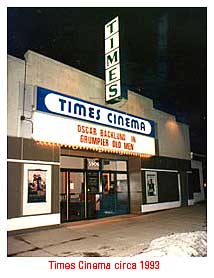
The Times, 5906 W. Vliet St., is being sold to Larry Widen, a freelance writer, film buff and former marketing director at Covenant Healthcare. Widen is buying the business from long-time owners Eric and Sue Levin, and he will employ Eric Levin as the cinema’s general manager.
Widen declined to say how much he’s paying for the business, or for the 9,000-square-foot building. The real estate is being sold separately to Widen’s brother-in-law, real estate broker David Glazer, who will eventually sell the building to Widen. Both the real estate sale and sale of the business are to be completed today.
Widen said his entire investment, including the planned improvements, will total around $500,000.
The Times, a single-screen theater known for showing independent films and the occasional classic movie, is “a real neighborhood gem,” Widen said.
But the business has been underused, he said. Widen said the planned improvements are designed to help showcase a wider variety of films, as well as live events, including three blues concerts already booked for this spring.
“I think the audience is there,” Widen said. “It’s just a question of providing a variety so we can be more things to more people.”
The first project will be an expanded concession stand, including a pizza oven and coolers for wine and specialty beers, Widen said. He said the cinema has applied for a tavern license.
Ald. Michael Murphy, whose district includes Washington Heights, said he supports the tavern license application, pending a meeting with nearby residents to get their views. Murphy said he doesn’t anticipate any objections from the cinema’s neighbors.
The expanded concessions, especially wine and beer sales, will help boost the cinema’s profit margins, Widen said.
The tavern license also will make it possible to stage live music performances. Blues harmonica player Corky Siegel has been booked for an April 28 concert, with bluesmen Sam Lay and David “Honeyboy” Edwards set for separate shows in May and June, Widen said.
Widen plans to install new seats with cup holders. The aisles will be wider, and some of the front rows will be removed to make room for easy chairs and sofas, he said. Those changes will reduce the cinema’s seating capacity from around 440 to 350.
Also, a digital video projector will be installed. That will allow the cinema to show documentaries, animated shorts and other limited-release items that film studios are making available only on DVDs, Widen said.
Along with the videos and live performances, the Times also will be booking more classic films to complement its lineup of new independent releases, Widen said. He said a recent showing of “It’s a Wonderful Life” drew a very strong audience.
Eric Levin, who partnered with his mother to buy the Times in 1993, said it was difficult to accept “that loss of autonomy” that comes with selling the cinema. Before acquiring the Times, the Levins operated the Avalon Theatre, in Milwaukee’s Bay View neighborhood, for seven years.
But Levin also said selling the Times creates an opportunity to expand the business.
“Larry does have access to the capital to make improvements,” Levin said.
Widen said his funds to buy and improve the cinema come from savings and investments. He is not borrowing any money for the project.
Widen is a former longtime advertising and marketing executive. His positions included serving as marketing director at Covenant Healthcare from 1992 to 2002. He also is a freelance writer and author, whose books include the recently published “Silver Screens: A Pictorial History of Milwaukee’s Movie Theaters.”
The building that houses the Times is being sold separately by Jay Hollis, who operates the Rosebud Cinema Drafthouse, at 6823 W. North Ave., in Wauwatosa. The Rosebud primarily shows first-run mainstream films, has sofa seating, and serves beer, wine and cocktails.
Hollis decided in August to sell the building. Hollis made that announcement after failing in his legal effort to oust the Times Cinema in hopes of creating a new business in its place.
Widen said he considers Hollis a “friendly competitor.” Even though the Rosebud and Times are relatively near one another, the Rosebud’s focus on mainstream films caters to a different audience than what the Times Cinema targets, Widen said.
“There’s room for both,” said Hollis, who recently partnered with restaurant owner Michael Feker to open Il Mito Enoteca, an Italian eatery at 6913 W. North Ave.
Our Oriental Treasure
by James H. Rankin
Milwaukee has a number of distinctions that make it a nice place to live, but did you know that our ORIENTAL THEATRE was one among them?
It certainly is according to international theatres expert David Naylor writing in his book “Great American Movie Theatres” on page 178:
“The 2100-seat Oriental is about as fine a neighborhood theater as one could want.” High praise indeed, but our ORIENTAL is of such a high caliber that it would serve well to grace the downtown of most any city.
That we are not provincial in accepting Mr. Naylor’s opinion is confirmed by New York City theatres historian, Elliott Stein, who wrote: “And then what was for me THE revelation of the trip: the Oriental…” and “Dick and Bauer, architects, wherever you are, thank you.” (“Film Comment,” March/April, 1979, pg. 41).
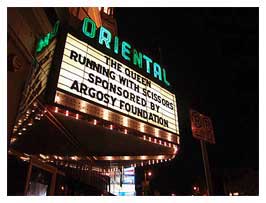
And recently in the national newspaper “USA TODAY” they ran an illustrated story: “10 Great Places To See A Classic Cinema” (Travel section, Friday, Nov. 23, 2001) which featured our ORIENTAL among that select group across the nation, according to the mavens at www.CinemaTreasures.org. Local architects Gustave Dick and Alex Bauer are no longer among us to accept such praise, but in 1927 when the ORIENTAL opened they proved their artistry and even preceded it with several other theatres whose names some may recall: the COLONIAL, PLAZA, GARFIELD, MILWAUKEE, TOWER and the NATIONAL. The fact that not one of these structures still stands as a theatre should give us all the more appreciation for our wonderful ORIENTAL, among the last of our movie palace heritage.
Movie palaces were opulent theatres usually designed to a decorative theme, such as the East Indian decor in this case, in order to draw patrons from the dozens of competing movie houses that sprouted during the building craze of the ‘Roaring Twenties.’
Milwaukee was blessed with more than the average of highest quality theaters such as the PABST, WARNER (last open in ’95 as the GRAND Cinemas, now being eyed by the Milwaukee Symphony), EGYPTIAN, and, of course, the ORIENTAL. Such theatres, aside from the PABST, were built to showcase the craze of the silent films and each therefore had provision for a small orchestra to accompany the film as well as a special theater pipe organ for matinees and preludes. The extra large Kimball brand organ was removed from the former WARNER when that theater was divided in 1973 and later installed and greatly enlarged in the ORIENTAL (the much smaller Barton organ originally there had been sold many years ago.) The majestic, yet very sweet sounds of this three manual, 38-rank (voice) “one man orchestra” can still be heard there several times a year, courtesy of the Kimball Theater Organ Society.
Let us investigate some of these things and thereby increase our own appreciation. Movie palaces were designed to attract attention, of course, and certainly those floodlighted minarets of white glazed terra cotta with copper onion domes would spell fantasy and exotic adventure to any passerby. Unfortunately, the original bronze marquee and four-story-high vertical name sign have been removed and the marquee is now a standard 1940s fluorescent version with a simple neon name sign. Gone are the light bulb-filled miniature minarets, which topped the original with swirling colored lights.
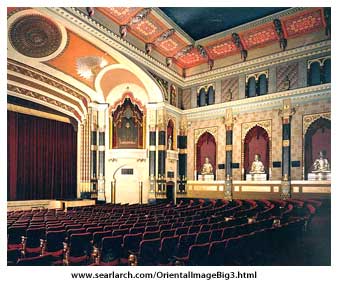
The Gateway to this island of fantasy is appropriately signaled by the adorable little box office which is more Moorish in feeling than East Indian but the charming walkway formed by the ticket foyer is now introducing us to some of the elaborate stained glass light fixtures and stucco walls we will enjoy beyond those doors to the Grand Lobby. As the door is opened, we are greeted or should say overwhelmed by the lavish but gracious spectacle before us; a truly Grande lobby which many larger cities would wish for their downtowns, and we have it in a neighborhood! What do your eyes see first… the three eight-foot-high brass and bent glass chandeliers with their eight matching sconces blazing with light? If so, you will see some of the finest glass and metal work custom built by Milwaukee’s Chas. Polacheck & Bros. Co. From the attic, manual winches lower these heavy fixtures.
Little children, however, seem to always first notice those eight, black glazed terra cotta lions forming the balustrade of the Grand Staircase. They are symbolic of the Buddhist guardians of the temple, according to the architects, and are actually formed of four carefully joined pieces. The blend of East Indian religious motifs is apparent in the Hindu as well as the Buddhist ornament, as the architects labored to eschew the frightful and bizarre elements of those designs of the Orient so foreign to Occidental eyes, as Alex Bauer made clear in his unusual newspaper prologue to the 1-1/2 million dollar theatre. Typical of the more acceptable motifs are the various miniature incarnations of Shiva and Vishnu in the little corner niches of the pedestals of the faux black marble pilasters. These and others in the theatre were modeled after the banded pillars of Kankali, Mathura, and Amaravati. The elephant-headed Ganesha is a benevolent deity to the Hindus, and so he is depicted here in silver leaf, obligingly acting as the bracket to support those mock teakwood beams. Originally, the now solid reddish brown bays between the beams had graceful arabesques painted in gold, but roof leaks over the years necessitated repainting.
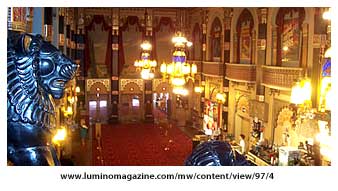
A Mr. Thomas of Chicago who evidently felt more familiar with the view of the Dardanelles than the Ganges, but presented a lovely vista, nonetheless, painted the murals between the pilasters. Also significant to the oriental plaster ornamentation are the multifoil and horseshoe arches as well as the majolica tile panels of the elephants with howdahs upon their backs. The A.H, Bluel Co. is to be given credit for the superb plaster work, but as is often the case, no mention is made of the artisans responsible for all this fine work, which in this case was Milwaukee’s own Anthony Spalthoff who subcontracted the casting of the ornament by Bluel’s production crews based upon his models. Mr. Spalthoff designed the ornament for Dick & Bauer’s remodeling of the 1895 PABST Theater in 1928, as well as many other projects before his death in 1933.
The lions may growl silently as we ascend the Grand Staircase to the Balcony Promenade, which is infinitely enhanced, by the six balconies that are framed in green damask draperies of a floral design. The astute observer will notice that the draperies in this area have been stripped of that little ornament which few people think of, but which one misses when it is gone: the tassel. The ORIENTAL originally had at least 60 of these special ornaments which were custom designed by the E.L. Mansure Co. of Chicago, and which are listed prominently (along with a photo of the ORIENTAL’S organ screen) in their 1928 catalog as No. TH-350. They were only $15 each then for one with a 3-1/2 inch diameter mold and an 18-inch overall length. If that company existed to replace those tassels at this time, they would charge the prevalent market price of about $300 each! They are made of rayon, not silk, which would be more expensive yet. Just one archway of these “simple” draperies would require over $5,000 to be replaced today, which shows why few theatres can afford to replace the textile decor.
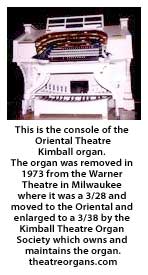
In the auditorium the organ screens are still lush with their original draperies of “lambrequins of ruby silk plush” with green satin swags heavily fringed and surmounted by a padded gold satin Pendant, studded with glass jewels and hung with tassels. Three matching Pendants once hung against the elaborate Grand Drapery and the gold satin House Curtain behind it, long ago removed. This House Curtain can be seen in early photos where there are two peacocks appliquéd with tails in full spread. The exquisite stage draperies also featured two larger versions of those Pendants: No. TH-563 in the Mansure catalog and 88-inches long at $160 each at that time (approx. $4,000 each today). They were rayon satin hand tinted in four colors and studded with large glass jewels. The artistry thus lavished on such theatres is very rare today, with the cost of reproduction of the ORIENTAL at probably 60 to 70 million dollars!
No doubt one of the principal glories of any theatre is its decorative lighting, and that is certainly true of our theatre. Over a dozen lighting groups are hidden in the two ceiling coves, the arches, niches, and beams. These circuits are each in three colors that could be mixed by means of dimmers to produce a dazzling variety of color “moods.” Unfortunately for our day, high energy and light bulb costs, as well as labor, make keeping all these hundreds of bulbs lit a daunting task. One of the causalities of this expense is the loss of the most unique lights to grace this theatre: the glowing green glass eyes of the baboon demons which encircle the lower ceiling cove with their feet upon the head of an elephant, and a lotus bud at the outer rim. These “ee-AHLees,” as one man from India identified them, lend a certain eerie mystery when their eyes glow in the darkness; we can only hope that they will be reactivated in future to again fascinate the children of a generation new to the ORIENTAL.
Despite having a full stage and the largest Kimball pipe organ in a theatre, and despite having some of the finest refreshments in one of the few theme decorated refreshment stands in a theatre, the box office receipts were not enough to continue a single screen policy. A decade ago the owners of the theatre, the Pritchett brothers, agreed to have two mini-cinemas built under the balcony in a tasteful way, and it is in that form that we now find the ORIENTAL. The competition for patronage is fierce what with other screens about town and the presence of TV and videos, so it will largely remain for those who appreciate such architectural treasures to support such glorious venues, or they will not long be with us. But how can we doubt the future of so entrancing a house when this telegram was sent over the name of a famous actress:
“I have heard much about your new Oriental and know that it will be the last word in motion picture theatres. Best wishes on its opening. Greta Garbo.”
James H. (Jim) Rankin has been interested in theatres ever since seeing “20.000 Leagues Under The Sea” at Milwaukee’s RIVERSIDE theatre in the mid 50s, and this prompted him to team more about these opulent structures. He had the privilege of assisting in researching “Milwaukee Movie Palaces’ and has been a member of the Theatre Historical Society of America since 1976. He has written for their “Marquee” magazine as well as descriptions for www.CinemaTreasures.org, and was the Archivist/Historian for the PABST Theater. He lives in West Allis.
Also see “Saxe-O-Grams“, a 1927 newsletter featuring the Oriental Theatre.
Our Oriental Treasureby James H. Rankin – ©2002
Milwaukee has a number of distinctions that make it a nice place to live, but did you know that our ORIENTAL THEATRE was one among them?
It certainly is according to international theatres expert David Naylor writing in his book “Great American Movie Theatres” on page 178:
“The 2100-seat Oriental is about as fine a neighborhood theater as one could want.” High praise indeed, but our ORIENTAL is of such a high caliber that it would serve well to grace the downtown of most any city.
That we are not provincial in accepting Mr. Naylor’s opinion is confirmed by New York City theatres historian, Elliott Stein, who wrote: “And then what was for me THE revelation of the trip: the Oriental…” an d “Dick and Bauer, architects, wherever you are, thank you.” (“Film Comment,” March/April, 1979, pg. 41).
d “Dick and Bauer, architects, wherever you are, thank you.” (“Film Comment,” March/April, 1979, pg. 41).
And recently in the national newspaper “USA TODAY” they ran an illustrated story: “10 Great Places To See A Classic Cinema” (Travel section, Friday, Nov. 23, 2001) which featured our ORIENTAL among that select group across the nation, according to the mavens at www.CinemaTreasures.org. Local architects Gustave Dick and Alex Bauer are no longer among us to accept such praise, but in 1927 when the ORIENTAL opened they proved their artistry and even preceded it with several other theatres whose names some may recall: the COLONIAL, PLAZA, GARFIELD, MILWAUKEE, TOWER and the NATIONAL. The fact that not one of these structures still stands as a theatre should give us all the more appreciation for our wonderful ORIENTAL, among the last of our movie palace heritage.
Movie palaces were opulent theatres usually designed to a decorative theme, such as the East Indian decor in this case, in order to draw patrons from the dozens of competing movie houses that sprouted during the building craze of the ‘Roaring Twenties.’
Milwaukee was blessed with more than the average of highest quality theaters such as the PABST, WARNER (last open in ’95 as the GRAND Cinemas, now being eyed by the Milwaukee Symphony), EGYPTIAN, and, of course, the ORIENTAL. Such theatres, aside from the PABST, were built to showcase the craze of the silent films and each therefore had provision for a small orchestra to accompany the film as well as a special theater pipe organ for matinees and preludes. The extra large Kimball brand organ was removed from the former WARNER when that theater was divided in 1973 and later installed and greatly enlarged in the ORIENTAL (the much smaller Barton organ originally there had been sold many years ago.) The majestic, yet very sweet sounds of this three manual, 38-rank (voice) “one man orchestra” can still be heard there several times a year, courtesy of the Kimball Theater Organ Society.
Let us investigate some of these things and thereby increase our own appreciation. Movie palaces were designed to attract attention, of course, and certainly those floodlighted minarets of white glazed terra cotta with copper onion domes would spell fantasy and exotic adventure to any passerby. Unfortunately, the original bronze marquee and four-story-high vertical name sign have been removed and the marquee is now a standard 1940s fluorescent version with a simple neon name sign. Gone are the light bulb-filled miniature minarets, which topped the original with swirling colored lights.
The Gateway to this island of fantasy is appropriately signaled by the adorable little box office which is more Mooris h in feeling than East Indian but the charming walkway formed by the ticket foyer is now introducing us to some of the elaborate stained glass light fixtures and stucco walls we will enjoy beyond those doors to the Grand Lobby. As the door is opened, we are greeted or should say overwhelmed by the lavish but gracious spectacle before us; a truly Grande lobby which many larger cities would wish for their downtowns, and we have it in a neighborhood! What do your eyes see first… the three eight-foot-high brass and bent glass chandeliers with their eight matching sconces blazing with light? If so, you will see some of the finest glass and metal work custom built by Milwaukee’s Chas. Polacheck & Bros. Co. From the attic, manual winches lower these heavy fixtures.
h in feeling than East Indian but the charming walkway formed by the ticket foyer is now introducing us to some of the elaborate stained glass light fixtures and stucco walls we will enjoy beyond those doors to the Grand Lobby. As the door is opened, we are greeted or should say overwhelmed by the lavish but gracious spectacle before us; a truly Grande lobby which many larger cities would wish for their downtowns, and we have it in a neighborhood! What do your eyes see first… the three eight-foot-high brass and bent glass chandeliers with their eight matching sconces blazing with light? If so, you will see some of the finest glass and metal work custom built by Milwaukee’s Chas. Polacheck & Bros. Co. From the attic, manual winches lower these heavy fixtures.
Little children, however, seem to always first notice those eight, black glazed terra cotta lions forming the balustrade of the Grand Staircase. They are symbolic of the Buddhist guardians of the temple, according to the architects, and are actually formed of four carefully joined pieces. The blend of East Indian religious motifs is apparent in the Hindu as well as the Buddhist ornament, as the architects labored to eschew the frightful and bizarre elements of those designs of the Orient so foreign to Occidental eyes, as Alex Bauer made clear in his unusual newspaper prologue to the 1-1/2 million dollar theatre. Typical of the more acceptable motifs are the various miniature incarnations of Shiva and Vishnu in the little corner niches of the pedestals of the faux black marble pilasters. These and others in the theatre were modeled after the banded pillars of Kankali, Mathura, and Amaravati. The elephant-headed Ganesha is a benevolent deity to the Hindus, and so he is depicted here in silver leaf, obligingly acting as the bracket to support those mock teakwood beams. Originally, the now solid reddish brown bays between the beams had graceful arabesques painted in gold, but roof leaks over the years necessitated repainting.
A Mr. Thomas of Chicago who evidently felt more familiar with the view of the Dardanelles  than the Ganges, but presented a lovely vista, nonetheless, painted the murals between the pilasters. Also significant to the oriental plaster ornamentation are the multifoil and horseshoe arches as well as the majolica tile panels of the elephants with howdahs upon their backs. The A.H, Bluel Co. is to be given credit for the superb plaster work, but as is often the case, no mention is made of the artisans responsible for all this fine work, which in this case was Milwaukee’s own Anthony Spalthoff who subcontracted the casting of the ornament by Bluel’s production crews based upon his models. Mr. Spalthoff designed the ornament for Dick & Bauer’s remodeling of the 1895 PABST Theater in 1928, as well as many other projects before his death in 1933.
than the Ganges, but presented a lovely vista, nonetheless, painted the murals between the pilasters. Also significant to the oriental plaster ornamentation are the multifoil and horseshoe arches as well as the majolica tile panels of the elephants with howdahs upon their backs. The A.H, Bluel Co. is to be given credit for the superb plaster work, but as is often the case, no mention is made of the artisans responsible for all this fine work, which in this case was Milwaukee’s own Anthony Spalthoff who subcontracted the casting of the ornament by Bluel’s production crews based upon his models. Mr. Spalthoff designed the ornament for Dick & Bauer’s remodeling of the 1895 PABST Theater in 1928, as well as many other projects before his death in 1933.
The lions may growl silently as we ascend the Grand Staircase to the Balcony Promenade, which is infinitely enhanced, by the six balconies that are framed in green damask draperies of a floral design. The astute observer will notice that the draperies in this area have been stripped of that little ornament which few people think of, but which one misses when it is gone: the tassel. The ORIENTAL originally had at least 60 of these special ornaments which were custom designed by the E.L. Mansure Co. of Chicago, and which are listed prominently (along with a photo of the ORIENTAL’S organ screen) in their 1928 catalog as No. TH-350. They were only $15 each then for one with a 3-1/2 inch diameter mold and an 18-inch overall length. If that company existed to replace those tassels at this time, they would charge the prevalent market price of about $300 each! They are made of rayon, not silk, which would be more expensive yet. Just one archway of these “simple” draperies would require over $5,000 to be replaced today, which shows why few theatres can afford to replace the textile decor.
In the auditorium the organ screens are still lush with their original draperies of “lambrequins of ruby silk plush” with green satin swags heavily fringed and surmounted by a padded gold satin Pendant, studded with glass jewels and hung with tassels. Three matching Pendants once hung against the elaborate Grand Drapery and the gold satin House Curtain behind it, long ago removed. This House Curtain can be seen in early photos where there are two peacocks appliquéd with tails in full spread. The exquisite stage draperies also featured two larger versions of those Pendants: No. TH-563 in the Mansure catalog and 88-inches long at $160 each at that time (approx. $4,000 each today). They were rayon satin hand tinted in four colors and studded with large glass jewels. The artistry thus lavished on such theatres is very rare today, with the cost of reproduction of the ORIENTAL at probably 60 to 70 million dollars!
and hung with tassels. Three matching Pendants once hung against the elaborate Grand Drapery and the gold satin House Curtain behind it, long ago removed. This House Curtain can be seen in early photos where there are two peacocks appliquéd with tails in full spread. The exquisite stage draperies also featured two larger versions of those Pendants: No. TH-563 in the Mansure catalog and 88-inches long at $160 each at that time (approx. $4,000 each today). They were rayon satin hand tinted in four colors and studded with large glass jewels. The artistry thus lavished on such theatres is very rare today, with the cost of reproduction of the ORIENTAL at probably 60 to 70 million dollars!
No doubt one of the principal glories of any theatre is its decorative lighting, and that is certainly true of our theatre. Over a dozen lighting groups are hidden in the two ceiling coves, the arches, niches, and beams. These circuits are each in three colors that could be mixed by means of dimmers to produce a dazzling variety of color “moods.” Unfortunately for our day, high energy and light bulb costs, as well as labor, make keeping all these hundreds of bulbs lit a daunting task. One of the causalities of this expense is the loss of the most unique lights to grace this theatre: the glowing green glass eyes of the baboon demons which encircle the lower ceiling cove with their feet upon the head of an elephant, and a lotus bud at the outer rim. These “ee-AHLees,” as one man from India identified them, lend a certain eerie mystery when their eyes glow in the darkness; we can only hope that they will be reactivated in future to again fascinate the children of a generation new to the ORIENTAL.
Despite having a full stage and the largest Kimball pipe organ in a theatre, and despite having some of the finest refreshments in one of the few theme decorated refreshment stands in a theatre, the box office receipts were not enough to continue a single screen policy. A decade ago the owners of the theatre, the Pritchett brothers, agreed to have two mini-cinemas built under the balcony in a tasteful way, and it is in that form that we now find the ORIENTAL. The competition for patronage is fierce what with other screens about town and the presence of TV and videos, so it will largely remain for those who appreciate such architectural treasures to support such glorious venues, or they will not long be with us. But how can we doubt the future of so entrancing a house when this telegram was sent over the name of a famous actress:
“I have heard much about your new Oriental and know that it will be the last word in motion picture theatres. Best wishes on its opening. Greta Garbo.”
James H. (Jim) Rankin has been interested in theatres ever since seeing “20.000 Leagues Under The Sea” at Milwaukee’s RIVERSIDE theatre in the mid 50s, and this prompted him to team more about these opulent structures. He had the privilege of assisting in researching “Milwaukee Movie Palaces’ and has been a member of the Theatre Historical Society of America since 1976. He has written for their “Marquee” magazine as well as descriptions for www.CinemaTreasures.org, and was the Archivist/Historian for the PABST Theater. He lives in West Allis.
Also see “Saxe-O-Grams“, a 1927 newsletter featuring the Oriental Theatre. Back to topics
Pabst Theater Heritage
by James H. Rankin
SEEDS OF THE PABST
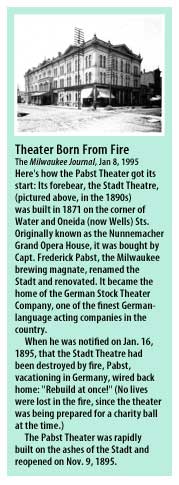
While the Pabst is not the oldest extant theatre in Milwaukee County (that honor belongs to the Ward Memorial Theatre of 1881 on the Veteran’s grounds, the former federal enclave of Wood, Wis.), it is the fourth oldest continuously operating theatre on the same site in the United States, and that is one of the distinctions that led to it being designated a National Historic Landmark of the US in 1991. That site was at first a shipyard along the Milwaukee River and the eastern portion a black smith’s shop, but when Swiss immigrant Jacob Nunnemacher and his sons sought a site for the first classy opera house in the city, it was here that they started construction in 1870. Ironically, these entertainment pioneers were in the same business as that of the Pabst brewery, libations.
For years this handsome Grand Opera House served the various ethnic groups in the city, but by 1890 the need for a larger site for the German’s theatre led Frederick Pabst, late of a captaincy on the great lakes steamers and now head of the brewery bearing his name, to purchase the opera house and drastically remodel it upon the same footprint, and christen it Das Neue Deutsche Stadt Theater (or: The New German City Theater, as the main such theatre in a city would be called in his native Germany). The original Stadt Theater had stood where the parking lot for the Hyatt Regency hotel is now on Third Street. Originally, this new Stadt theater was to be of a revolutionary design by famous Chicago architects Adler and Sullivan, but apparently the tradition minded burghers of Milwaukee, who made up over sixty percent of the city’s population at that time, were taken aback by such a nontraditional design and persuaded the Captain to hire a local man more familiar with local tastes. It was then given to Carl G. Hoffmann in conjunction with local panorama scenic painters such as Georg Peter to design and decorate in a Germanic flavor complete with the names of German notables of the arts painted in ornate frames upon the archivolt of the auditorium, a device later expanded in the Pabst to literati of other nations as well.
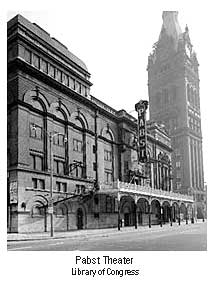
The Stadt may have continued as it was for years had it not been for an opportunity for remodeling presented when a fire started in the basement kitchen of the attached cafe and caused extensive smoke damage and the necessity of rebuilding the basement areas of the theater as well. With this need to close the theater for a time, the occasion was used to have Pabst brewery architect G. Otto Strack redesign the boxes in the auditorium to better the acoustics and sight lines, and thus this man got his first opportunity to put his mark upon this theater, even though his design for it had been rejected in 1890. The Stadt continued for two more years until finally a disastrous fire reduced all but its foundation and some of its walls to rubble in January of 1895. Preparations for a charity ball had been under way with streamers of tarlatan radiating from a chandelier of open flames, one of which ignited the streamers. Though valiantly fought in near zero temperatures, the multitude of fire companies could save only the four bays of the attached commercial and office building which was separated from the theatre by a brick firewall.
Vacationing in Europe at the time, the Captain when informed of the disaster, reportedly cabled:
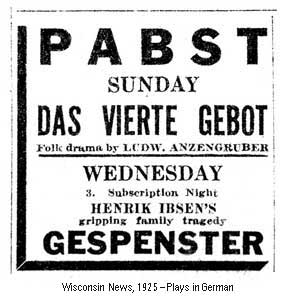
“Rebuild at Once!” to his architect on staff, Otto Strack. Herr Strack was not ignorant of theater design after having studied in Germany and having seen many theatres there, and then he also took a quick tour of the foremost theatres in the US within months after the fire. Since he had to build on the same foundation of the Stadt, there was no opportunity to enlarge before the next theatre season would begin in the autumn. Instead, he concentrated on devising the most fire proof theater built up to that time, and one of the most comfortable and ornate since it would now bear his employer’s name; PABST.
HER COMING-OUT PARTY
In a remarkably short span of eleven months the Grande Olde Lady was born as a new theater was designed and built with many innovations, such as the fact that the superstructure was of cast iron and concrete, the only wood in the building being the stage floor and the window frames. No sources of flame were allowed since this was to be our first all-electric theater. Even the traditional “fire curtain” built into most theaters to close off the stage from the audience in the event of fire and usually woven of asbestos over cotton cords, was here a unique fabrication designed to outlast most any fire. It was an iron frame 38 feet wide by 50 feet high having wire mesh on both faces with the space between them filled with firebricks. No fire was ever going to destroy this barrier as it had so many asbestos fire curtains in the past!
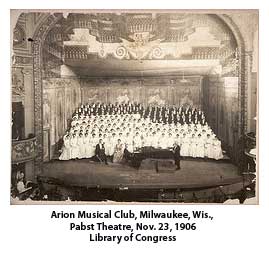
A very efficient stage with the newest technologies for the performers assured excellent productions, among these technologies being the first use in the city of a complete permanent steel counterweight system to fly scenery and draperies without the old “slots’ for sliding scenery frames which had dominated stagecraft for nearly a century, as well as the first national use of an all electric lighting system, according to national theatres expert David Naylor writing in his “American Theatres; Performance Halls of the Nineteenth Century” page 120. Even the stage floor was in three sections that could be raised or lowered by remote control to affect some dazzling dynamics. In the spacious orchestra pit now resided at center position the console of probably the first electric pipe organ in a US theater, certainly the first to have its wind provided by an electric blower. The balcony and gallery were of semi-cantilevered construction thus almost eliminating the view-blocking columns common to theatres before this. The 1800 seats were on concrete floors with down flow air circulation through registers under them, probably among the first such in the nation.
The attention to luxurious decor and comfort was not absent in the rush to a fireproof theater, and the idea pioneered at the Stadt of having names of notables inscribed about the cornice of the drum shaped auditorium was enlarged upon in the Pabst to act as a visual tribute to the Stadt. The dominant ornament was the statue of Apollo some seven feet high flanked by the muses of Drama and Song upon the apex of the proscenium arch, all in gold leaf. Fourteen boxes flanked the stage allowing the local ‘beer peerage,’ as one wag put it, to dominate the evenings in regal splendor. To enhance that splendor and cause the ladies’ diamonds to sparkle was the task of the innovation of unusual lighting. Since only dim carbon filament bulbs existed at the time, provision was made for over a thousand of them to adorn the balcony and gallery fascias, the dome, and other fixtures; but these would still provide only soft light that complemented the ladies’ complexions. What was needed was brilliant lighting to sparkle diamonds and show off the hand wrought gold metal thread tiebacks upon the deep maroon velvet hangings and the richly tasseled gold house curtain on the stage, so eight carbon arc street lamps were installed above a 16-foot diameter circle cut in the theater’s dome and below which was hung a “bowl” or “veil” of crystals to scatter the brilliant white light. Imagine the dazzling brilliance as the gorgeously coifed and gowned ladies with their gloved arms upon those of their men in evening dress and top hats promenaded into the auditorium and took their seats as the bright white light extinguished and the glowing quality of the little light bulbs remained until dimmed out themselves as the orchestra struck up the overture.
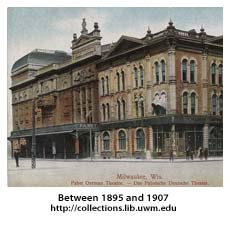
While the heating from the Pabst Brewery power house blocks away was sufficient to provide the physical warmth that the glittering decor already suggested, the real claim to comfort came in the summer when some 10 tons of ice was carried by the back stage electric elevator up to the attic and transferred by a small railroad across to the auditorium attic where it was placed before two 13-foot-diameter fans which sent delightful waves of cooled air down to the heretofore sweltering audience in the days before air conditioning. A bow must be made to Adler and Sullivan’s Auditorium Theatre in Chicago for this idea, and that of the carbon arc auditorium lights from the 1882 Exposition Theater of Munich, Germany. Opening night was November 9, 1895 and the SRO event was the talk of the town as one carriage after another pulled up to the carriage lobby entrance under the tight bulb studded arcade supporting the canopy along the four story brick, limestone and granite facade. Gold leafed metal urns and a lyre surmounted the parapet with the terra cotta letters spelling out PABST THEATER to this day.
It was a grand program with dedicatory speeches and even a special “Pabst Theater Festival March” composed by orchestra conductor Christopher Bach and played for the occasion on the new 35-voice electro-pneumatic pipe organ by our architect cum organ engineer and entertainer, Otto Strack. A farce in four acts from the stages of Berlin that season was featured: “Zwei Wappen,” (Two Coats of Arms), a ‘Romeo and Juliet’ retelling with an American cousin visiting a family in Germany. At intermission, the Captain and his family stood in their box and graciously accepted the applause of the appreciative audience. A happy crowd thronged the ‘refectory’ in the basement where the men enjoyed intermission with (what else?) Pabst beer, and after the show they retired with their ladies to the adjoining Pabst Theater Cafe where they further imbibed by toasting the future of so glittering a showpiece showplace.
MID-LIFE CHANGES
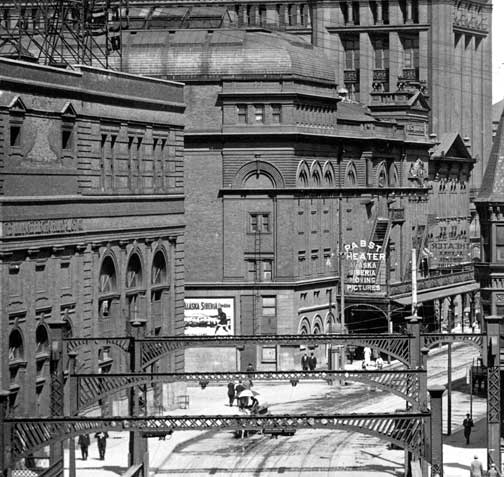
The Pabst enjoyed many more seasons of German touring companies and also hosted the resident German theatre groups, interspersed with occasional English language occasions. With the outbreak of World War I, things changed drastically for the Pabst. No longer were German touring companies available, and in the Teutophobic days that ensued, anything German was discouraged. By the 1920s, most of the productions were in English and the theater saw many other uses as for political rallies, religious ceremonies, chataqua discourses and numerous concerts of the Chicago Symphony and countless other artists of the stage, so much so as to feature a complete roster of the American stage for the next fifty years. The advent of motion pictures and the decline in attendance at traditional theatre caused the Pabst to look tired by the mid-twenties, so local theatre architects Gustav Dick and Alex Bauer (who had just completed their work on our Oriental theatre) were engaged by the owner, the Pabst Brewery, to remodel the aging theatre into new vitality. Gone now were the boxes, the pipe organ, the stage elevators, the unique fire curtain, and the brilliant carbon arc lighting, which was replaced by an art glass ‘disc’ fixture which filled the original opening with standard tungsten filament bulbs behind the stained glass which was done in an art deco motif. The new color scheme was greens and gold, and the mechanical air washing and cooling machines of the day usurped the basement, the outmoded ice cooling having melted away. Gone too, by now, was the Captain himself and thus a new generation and a new era had begun.
The Great-Depression years followed with reduced patronage, but little change to the building, and the days of World War II saw many Gl’s but little advancement aside from the 1928 movie palace-styled vertical sign of the theatre’s name on the facade fading more. As the war ended, the brewery sought to divest itself of the theatre even as it had divested itself of other real estate acquired by its founder. It was decided in 1953, that a foundation would be formed of three local foundations to own and run the theater which was turned over to several promotional companies. During this time such names as Liberace, Louis Armstrong, Liza Minelli, Beverly Sills, Jack Benny, Rita Moreno, Billy Joel, and Dave Brubeck trod the stage in between various film showings from the projectors installed in the Twenties in a former trunks storage room. Follow spotlights were installed to follow these great names, but a new foe appeared on the scene to drain away the audience: television.
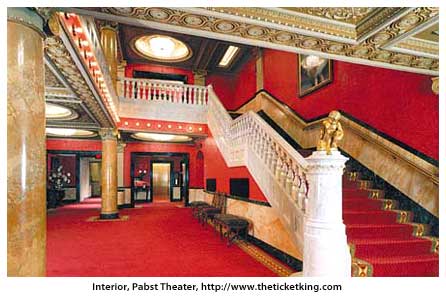
With an abundance of movie houses already competing in the city, it was thought pointless for a fine legitimate stage facility like the Pabst to continue with films, especially since such stages as the Davidson, the Garrick (Bijou), and the Academy of Music (Shubert) were now gone. By 1961, the city acquired the theater and then sublet it to the foundation to continue its previous mixed-use policy. The city spruced up the again aging interior with new draperies, asphalt tile flooring to replace the worn carpets and other minor efforts to forestall decay. Uninspired leadership caused the old lady to be used less and less, and there was talk of demolishing it for much need parking for City Hall across the street. By the end of the Sixties, however, the county’s Performing Arts Center was beginning construction just two blocks north. Then mayor Henry Maier was envious of another government’s progress in its new travertine marble hall, and dismayed at the loss of so many performance dates to the new PAC, so he and others knowing the potential of the Pabst sought to rescue it from its oblivion.
RENAISSANCE
In 1967 the city sought local landmark designation for the Pabst, which it received. They then sought listing on the National Register of Historic Places from the federal government to document its significance to all (granted in 1972), and the awarding of that designation was the springboard for the accumulation of public and private funds to finance the 2-1/2 million dollar refurbishment which was never intended to be a real restoration. Nonetheless, by 1976 the often dark dowager of Wells St. was revived by a makeover that didn’t restore the box seats, but did restore the red, maroon and gold color scheme, newer, brighter lighting, a complete regilding by the same artisans who had done the 1928 remodeling, Conrad Schmitt Studios, as well as new stage hardware, electronic lighting, a forestage elevator and a new pipe organ. The exterior was finally given the many repairs it needed, and the air-cooling of the 1920s was replaced with the freon air conditioning of the 1970s. The Olde Lady was again resplendent in new frock and jewels and many thousands of people attended the grand re-opening on September 23rd, 1976 as did this writer and thrilled at the glorious ‘new’ opera house that greeted yet another generation into yet another era. The Performing Arts Center may have been larger, but the intimate Pabst, with superb acoustics praised since its opening, was now going to try to be Mayor Maier’s “People’s Theater.” More local groups were booked into the Pabst and some even saw their births there, but it still remained dark for too many days of the year under a succession of managers.
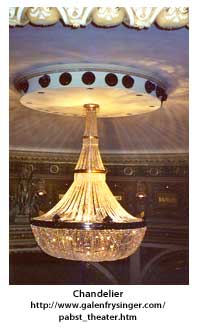
In 1989 a new “hyphen” was added to the Pabst in the form of a connecting transitional corridor from the high tech attitudes of the new adjoining Milwaukee Center office/hotel complex, to the new north grand lobby of the Pabst, decorated to harmonized with the restored 1890s opulence of the theatre itself, complete with a gilded and coffered ceiling, an ornate hand carved wooden back bar from a local mansion, and ‘puddled’ damask draperies 12 feet high. A series of showcases along this transitional corridor contain photos, programmes, and memorabilia of the many greats who have graced its stage. In this same era came a new Executive Director, Philip Procter, a native Milwaukeean, who got the place going by encouraging its use by many more diverse groups, and even found a bust of the late Captain to add the historic nexus.
His dynamic tenure also sought and obtained the coveted designation of National Historic Landmark of the United States, an honor held by Carnage Hall in New York City, Ford’s Theatre in Washington DC, and only a couple of other theatres in the nation. This writer was privileged to be engaged by Mr. Proctor to compile and write the two volumes (retained at our Central Library, as well as the National Archives) which were sent to the federal government to document the importance of the Pabst, both in history and in present, to the United States in general as well as locally. In its Nomination Volume in 1991, the Department of the Interior writes in “Summary:”
“The Pabst Theater is the best preserved German-American theater in the United States and is one of the most tangible reminders of the cultural role of Milwaukee, the “Deutsch Athen” (German Athens), as it was known to generations of German-Americans. The Pabst is also important in theater design and for its long-time multi-cultural appeal…. The Pabst thus is nationally significant for both its importance to German American history and for its significance in the history of the American theater. It has been praised and appreciated by performers and theatergoers of many nationalities for nearly a century.”
I was told that this is one of the few Nominations that received unanimous recommendation from the survey committee and it was submitted to the Secretary of the Interior for his signature, which he bestowed on December 10th, 1991.
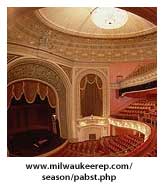
Aside from the production every December of the Milwaukee Repertory Theater’s “A Christmas Carol,” the Pabst is too small to originate any substantial productions and thus sees its days as a ‘road house’ for touring groups on a rental basis. This realization puts even more emphasis on making the theater suitable for both diverse productions as well as maximum use of its seats. To this end, a capital campaign was resumed in 1998 with the object of reseating the gallery with seats for now larger Americans (a new total of 1300 in the theater), passenger elevators to there and other levels of the theatre, enhanced air conditioning, and the restoration of a cafe, or “Cudahy’s Irish Pub” as it is now called, to the east side of the original lobby. This last item was a gift of $1,000,000 through the generosity and foresight of local philanthropist Michael Cudahy who long knew the value of so original and historic a location to the city. With the completion of this campaign and its wonderful additions in early 2002, the Pabst again can accommodate the most people with the greatest comfort amid splendid surroundings. The Grande Olde Lady is again a young bride in all her splendor awaiting her groom.
Like most cities, Milwaukee is fighting a drain on its tax base, and thus seeks to shed as many financial burdens as possible, and just when no one knew who could successfully take this burden from the city that admired it but could no longer afford it, along comes Mr. Cudahy yet again, this time to offer to purchase and run the theater through his foundation. His daring and foresight are very commendable and he explains that he seeks to make the theater yet more useful to more local and national groups as well as to put money into those areas needing care that previous funds could not accommodate. He has the vision to see the fact that the Pabst has a dedicated crew of acolytes at this temple of Thespis and pledges to retain them and add such personnel, as the theater has needed for many years.
The Pabst Theater – A Paragon of Playhouses
by Jim Rankin
This is the Paper which was submitted to the Secretary of the Interior to gain Landmark status for the Pabst Theater.
Preface
In 1974 there was considerable discourse on saving the Pabst Theatre, then owned by the City of Milwaukee. The grandeur was long gone – an aging relic of the past in disarray. If it were to be saved, how would this be done? I guess that the Theater had a guardian angel named Jim Rankin. He was the Curator for the Restoration of the Pabst. In a critical turning point for the Pabst, Jim Rankin wrote this 38-page Paper on the Pabst Theater that was submitted to the Secretary of the Interior. This Paper was instrumental in acquiring National Historic Landmark status for the Pabst Theater. A National Historic Landmark is a building officially recognized for its historical significance, which is quite rare. During renovation Jim was the one person who really understood the history and architecture of the building. An old office full of forgotten theater records was discovered, and somehow, they were thrown out. Jim, of course was just sick about this. In any event, Jim is gone now, leaving us a legacy of wonderful articles and a grand lady called the Pabst. Thanks, Jim!
MILWAUKEE’ S PABST THEATER
A PARAGON OF PLAYHOUSES by James H. Rankin, with the invaluable assistance of Lillian Procter, Mrs. and Mr. Philip Procter – Copyright PABST THEATER, 1990
Of all the architecture of man, no form has been written more of than the theater. It embodies the hopes and frustrations, the laughs and tears of the entire human panorama. If the performing arts were to properly reflect and celebrate this pageant of history they had to be housed in structures suited to that purpose and to the encouragement of the comfort and attentiveness of an audience. The following will show how Milwaukee’s PABST THEATER was and is a most notable high point in this wedding of the performing and the structural and the decorative arts, and therefore deserves National Landmark recognition as a true landmark of progressive theatrical achievement for the past century. This Paper will show several significant areas in which the PABST was either the first or certainly among the first to employ state-of-the-art advances in the history of theater, drama, music, and the architectural appurtenances and atmosphere so necessary thereto. The United States has, regrettably, allowed many of its theatrical structures of early years to vanish and the loss to our posterity is irretrievable. Modern theaters too often display a primary concern for economies of construction and therefore we need to preserve examples such as the ornamented PABST to display hand craftsmanship. As will be discussed further on, the PABST is one of only five theatre buildings still operating continuously upon the same site for over a century in these United States, and it not only has a virtual encyclopedic history of the English language stage, but also that of the German as well. Where is its equal? It is truly a Paragon without peer.
PABST THEATER HISTORY: LONG AND DISTINGUISHED
The city of Milwaukee celebrated its Semi-Centennial in October of 1895 With nine of its English and German language newspapers issuing special enlarged editions, and no doubt exists that had the PABST opened just one month earlier it would have found itself among those things celebrated as fine examples of the notable progress of an American city. True, the erection of yet another theater is not an especial cause for note from the perspective of the 1990’s, but the PABST was exceptional from a variety of viewpoints, as the following will make clear. Theatre, or Drama, in Milwaukee began in 1842 with the erection of the John Hustis Hall and the English drama staged by the Yankee settlers here. The German-speaking settlers started arriving especially after the 1848 “revolution” in Germany and these “48’ers” as they were sometimes referred to lost no time in continuing their ancient thespian history in this new homeland, with their group: the “Liebhaberverein”, just eight years after the English, in 1850. The course and subsequent triumph of Milwaukee’s German language theater, which seeded itself actively throughout the Mid-West, has already been told in PART I of this Paper in September, 1990; now we will concentrate on the progression to the PABST: a sequence of theaters culminating in one of the finest playhouses this nation would ever know.
THE GRAND OPERA HOUSE
The John Hustis Hall was not a theater in reality and its limitations for drama (not to mention opera or symphony) were all too apparent to one Jacob Nunnemacher, a Swiss immigrant who loved theater and certainly saw the need for a real one in fledgling Milwaukee. After some years of amassing a profitable distilling and real estate business, he, with his son Herman, was in the financial position to indulge his passion for theater, so he built his GRAND OPERA HOUSE on a low area which was at one time a ship yard near the Milwaukee river at the intersection of Oneida and River streets – coincidentally across East Water street from the future city hall. To those unacquainted with Milwaukee of that day it may be expected by them that the name of Mr. Nunnemacher’s edifice was pure hyperbole – part of the ballyhoo so common to American enterprise. Perhaps a sophisticated Easterner of the time would imagine a cluster of benches on a board-covered dirt floor with two or three kerosene lanterns hanging from the rafters of a false-fronted barn. As the following newspaper transcription and photograph make clear, such a one would certainly be surprised to learn the truth. (Please see the GRAND OPERA HOUSE exhibits herein) What bearing does this have on the PABST? This is the PABST’s first predecessor for it was on this very site – and somewhat on the very same foundation – that a landmark playhouse was to arise only 29 years later. A young man in the brewing world – late of a steamship captaincy on the Great Lakes – Frederic Pabst had only been in Milwaukee for a little over a decade and was therefore not only aware of this distiller’s claim to fame, but also of the theatrical situation in Milwaukee. Another chapter herein will detail the Captain’s life, but mention is made here to show how the Captain may have coveted such a handsome structure with his name on it. As you will see, Fred Pabst was undeniably a generous man, but also one with a normal vanity and consciousness of human mortality. The Munnemacher GRAND OPERA HOUSE found the late 1880’s a difficult for English speaking theater, partly because its patrons were less fervent than were those of the German language theater and also because it had to share its audience with several other theaters at times, such as the MUSIC HALL (later called THE ACADEMY OF MUSIC). In contrast, the elaborate German STADT THEATER, only four blocks westward on 3rd St., was in its ascendancy ever since it was built in 1869, to the point that a larger structure was needed. Because the STADT could not be enlarged again [as detailed in PART I of this Paper] the German community leaders came to Capt. Pabst for a solution. The best available one for quick results was to purchase and remodel the GRAND OPERA HOUSE, which he did. He would not only get a large facility at a bargain, he would remove the name of a friendly competitor in the libation business from the public eye. While the Capt. agreed to pay for extensive interior remodeling of Nunnemacher’s, he was, apparently, not ready to put his name on a structure he had not built himself; after all, he was a man of principle.
THE NEW STADT THEATER
On September 17th, 1890 the sparkling new theater remodeling was christened “DAS NEUES DEUTSCHES STADT THEATER” (The New German City Theater) or “New STADT”, for short. This re-design was to be nearly state-of-the-art with the noted Chicago architectural firm of Adier & Sullivan retained to do the plans. As discussed in the annotated Historic American Buildings Survey document herein, Adier & Sullivan’s plans must have been too radical for these German-Americans, because another architect re-did their designs quite differently, incorporating a reverence for the Germanic heritage and artistic standard quite lacking in the famous duo’s work. Architect Hoffmann’s design virtually obliterated Henry Koch’s design of the Nunnemacher interior, but the result was quite well received and successful.
Such success did not prevent arson to the NEW STADT in 1893, but this did provide the opportunity for the chief resident architect of the Pabst Brewery to display his talents in theater design – a rare and most rewarding challenge for any architect to this day. Otto Strack took advantage of the opportunity to correct a visual and acoustic problem inherent in the box seat design of Carl Hoffmann for the NEW STADT. It seems that the Captain was well pleased, for when on the day of January 15th, 1895 a fire broke out in the NEW STADT, it caused the complete loss of the theater portion of the building, and Capt. Pabst, who, when he was wired the news while vacationing in Germany, did reply: “Rebuild at once.” This message came to Otto Strack, and thus the PABST THEATER was born upon its lineal predecessors: the 1871 Nunnemacher GRAND OPERA HOUSE, and also upon the 1890 NEW STADT THEATER. The PABST might thus calculate its origin as dating from the GRAND OPERA HOUSE in 1871, a total of 119 years up to now. That is 43,435 possible days for performances; even a fraction of these would be an impressive record of virtually every name of importance in the history of both American and German drama and theater in the United States. Perhaps only the NATIONAL THEATRE in Washington, D.C. has a longer lineage on the same site of dramatic performances not interrupted by years of operation as a movie house. According to the Directory of Historic American Theatres (1985, League of American Theaters, Washington, D.C.) only three theatres in the U.S. have a longer history than the PABST in presenting continuous live performances on the same site without movies in a structure built as a true theater, and they are all in Pennsylvania. There are, of course, many older theaters than the PABST, but most of those extant have been converted to movies or other uses. For the PABST to be the fifth oldest continuous performing theater site (the first oldest in terms of German language theater) in the U.S. is no small claim to fame.
THE PABST THEATER
The Captain’s generosity was severely tested twice since 1890, but now he was going to have a theater according to his design and therefore worthy of bearing his name to posterity. Otto Strack, the German-born architect attached to the Pabst Brewery had never designed a theater from scratch, but he proved himself more than equal to the task. After the fire, he took a quick trip to see other American theaters and combined his ideas from them with his knowledge of European theaters he had studied long ago. The local newspaper articles on and about the opening day of the PABST (Saturday, Nov. 9th, 1895) were unusually detailed and clearly revealed Herr Strack’s objectives:
FIRSTLY: (for obvious reasons!) A totally fire proof theater without any gas service to avoid any open flames. (Electric light was now becoming wide spread due to rapid developments, even if the generators of the day were still somewhat undependable.) There were even 20 exits with little oil lamps enclosed inside distinctive EXIT lights just in case both of the generators failed.
SECONDLY: An acoustically excellent structure of the required size essentially upon the old Nunnemacher GRAND OPERA HOUSE foundation limits. This saved expense and time and still allowed a capacious theater once the old drug store portion of the Nunnemacher block (one bay) was absorbed for the new upper and lower lobbies.
THIRDLY: A state-of-the-art stage house to accept the flying of drops and other rigging from prime touring groups. The two motorized lifts extending the width of the stage were indeed revolutionary, with each lift having several traps in it. The author of the 1961 book: The Best Remaining Seats, Ben M. Hall, gives 1920s stage mechanic Jack Partington the credit for inventing stage lifts for movie palaces; it appears that Otto Strack proceeded him by almost 30 years! The large pipe organ was the fourth one to be installed in an American theater, and it was one of the very first electric ones, at that! The PABST was only the second theater in the country to use a motorized organ blower. Did any other theaters of the day have two fly galleries, a freight elevator from basement to above the gridiron and two painter’s adjustable bridges as well? These, and the unique Knickelbein Rigging System will be described in more detail elsewhere herein.
FOURTHLY: A gorgeous and lavishly decorated theater that would be a credit to the decorative as well as the performing arts. The provisions for audience comfort included not only plush, spring seats which both reclined and returned to “seat-up” position, but a pioneering total “air conditioning system” unknown in any other theater. It not only heated the air, but washed it in dense water sprays and blew it through ornamental grilles down to the first under seat ventilators (“mushrooms”) in any theater – a practice described as perfectly new in the 1927 book: American Theaters of Today where they give architects this “new” system which, unknown to them, quiet Otto Strack had developed in Milwaukee a mere 32 years before! As if this were not enough, the PABST was very likely the first air-cooled theater in the U.S. if not the world! Evidently there wasn’t time to finish the ice cooling system in 1895, because the PABST’s program of June 29, 1908 has this item:
ONE THEATER IS COOL
With the coming of real summer weather the management has placed in operation again the device, which makes the Pabst Theater the coolest playhouse in the world. Hundreds of tons of ice now fill the reservoirs in the dome of the building and the air, which is swept over it by huge electric fans, is forced through pipes to every part of the playhouse, making a delightfully cool temperature that patrons have been quick to show their appreciation of. This cooling device is operated from the electrician’s room and less than an hour’s notice is required to give the theater a most refreshing temperature.
The ornamentation in the auditorium and lobby is all of gold leaf carefully antiqued into so many forms from the more sweet motifs of the Baroque and Victorian as to constitute a lexicon of this age-old art. The photographs further on are labeled to show just what an educational and beautiful theme prevails.
Otto Strack’s accomplishment was very well received and the newspapers of the day were even more enthusiastic than is usual for such occasions. It must have been hard to keep the usual journalistic detachment in a structure as obviously exceptional as the PABST – and it was not in New York or even Chicago, but their own hometown out in the hinterlands. Herr Strack went on to design many more buildings including a “sky scraper” in New York City and a special pipe organ factory (one suspects that pipe organs were his first love.)
Many a celebrity found the PABST just perfect and the famous theater duo Alfred Lunt and Lynn Fontanne (who lived about 40 miles outside of Milwaukee on their estate in a little town called Genesee Depot) often opened and closed their touring season at their favorite theater, the PABST. Mr. Lunt is quoted in a letter reproduced herein regarding the PABST: “…It is truly unique in the theaters of this country.”
This uniqueness did not spare it from the ravages of time, of course, and the generation that founded it passed away; the “generation perspective” is such that each thinks only those things built in their time are really modern and therefore worthwhile. By the 1920’s the times were quite different, and a new breed of lavish theater threatened the survival of such “dowagers” as the PABST – movie palaces, most far larger than the PABST. While the PABST could and did show movies on special occasions, it was not designed as a movie house and, fortunately, it never became one. But it was still necessary for the theater to be bright and attractive enough to compete and some of the movie palaces (such as the presentation houses like the RIVERSIDE) were larger and far newer than the PABST and capable of stealing some of attractions with a larger and better-equipped venue. This competition factor is no doubt what brought the remodeling of 1928 to the PABST by Milwaukee movie palace architects Dick & Bauer.
As the enclosed H.A.B.S. annotated paper relates, the theater was primarily rehabbed in a technical and utility sense, not in a decorative one. The exterior in fact, was so little changed that they had to put up a 2-story electric vertical sign reading “PABST” a la the movie palaces, simply to reassure people that the theater had been re-vitalized to keep up with the times! The theater lost its boxes (no real loss in some ways) but aside from this it differed little from what it was before the remodeling. The lobby staircase was aligned along the wall to increase circulating space after the overflow provided by the doors into the attached cafe had been eliminated back in 1912 (and movie palaces had giant comfortable lobbies!) The color scheme was new and of a cool palette to contrast with the original gold and reds.
The theater continued in this traditional pattern of mixed uses until the 1960’s, having periodic refurbishments with new colors and fabrics – the things that wear rapidly in the public eye. The grandson of the Captain didn’t build the theater and in 1953 he sold it to a foundation, which appreciated it far more. They operated it under leased management until 1960 when they found it difficult to compete with their again fading jewel against television, professional large scale sporting events, a reduction in the quantity of touring companies, and movies. The city bought the theater and again leased it to others, but the times were still changing; it was the “now” generation, and Rock ‘N’ Roll was born. The PABSTS’s again fading grandeur was sadly out of step. The city had many other things to attend to and the PABST found itself far down the list. With the new mayor in 1960, Henry Maier, the PABST had found a new champion. The previous administration had not been as attuned to cultural matters, but Mr. Maier realized that the new Performing Arts Center, soon to be completed only a block from the PABST on a choice river side spot of land with its own parking structure (the PABST never had one!), would not be all things to all people. It would now become the new premier venue for symphony, opera, and large shows when it opened in 1969. The PABST therefore should be, he felt, a sort of “People’s Theater”, a poor man’s version of the larger P.A.C. suited to smaller events heretofore resigned to the few dingy stages still in town. There was talk of school groups and even sidewalk theater working out of the PABST.
At the same time, people began to realize that the PABST could be a compliment to both the city and the new P.A.C. Experts in theater had stated the need for the beautiful PABST even back in the 1950’s when the P.A.C. (or New Music Hall) was being planned. Suddenly people like the mayor, who had long taken Milwaukee’s gracious and gorgeous 19th century architecture for granted, were noticing our architectural heritage disappearing right and left. The new expressway system by itself accounted for the loss of over 1,000 buildings and dwellings! Now the mayor saw it not only taking people and jobs out of his city to the “iron ring of suburbs,” but also its destruction of much of the graceful pattern of this humble city. People started waking up. Studies were done. Newspapers carried articles on the PABST’s heritage (unknown to the far younger populace of the nascent baby boom generation and most of their parents) and letters were published decrying our destruction of our heritage. The PABST was a venerable dowager after all and could indeed be preserved and become vital again!
The rest, as they say, is history. With local landmark status and recognition through H.A.B.S. and the combined funds then available, the early 1970s restoration was soon underway. Back again was the opulent, gilded color scheme in a city with only a few badly faded gilded movie palaces yet hanging on. Back came the soft carpets and new draperies, crystal chandelier and sconces, and even the now imperative Freon air conditioning. We even saw again for the first time in over 40 years, the golden lyre and flaming urns glittering in the sunlight upon the PABST’s roofline. Milwaukee was proud in September 1976 at the heavily attended Grand Re-Opening, and justly so. They learned that few other cities could boast such a jewel, as testimonials poured in from those elsewhere who had seen the PABST and rejoiced at her re-birth. The Bicentennial Commission had even declared the PABST an official Bicentennial event. The Theater Historical Society saw this too and did a long article on her in their Marquee magazine. The league of Historic American Theaters honored her by staging one of their national conventions there, as had other organizations.
Unfortunately, the 1970’s restoration didn’t have funds for everything. The plaster dome remains un-adorned. The carved furniture of the “gilded age” had disappeared or broken long ago and there was no money to re-fill the empty lobbies. There wasn’t even enough for an elevator up to the 3rd and 4th floor offices, a fact recalled for every worker there every day, as well as to the “gallery gods” – those hearty souls who traipse up fourteen flights of steps to reach that aerie with its truly unique seats and a spectacular view!
SUMMARY
The PABST is not the largest theater in the U.S., and there may be a few more ornamental; but few if any can match its combination of distinctions as described more fully elsewhere herein.
TIME: Even if its heritage is seen only from 1895 rather than its direct predecessors origin in 1871 (The Grand Opera House of Jacob Nunnemacher) it is still a century of glory. It was dark for longer periods only in the 1960’s and never for entire seasons.
PERFORMANCES: Not only did it host virtually every English-speaking performer or lecturer of every description, it also did this for the German as well. We have recently found evidence that German language occasions continued well into the 1960’s.
FEATURES: To have started out as early as 1895 with the technical features listed herein is a claim to fame for any theater – and today it is again state-of-the-art, but with a great recall of early times as with the preserved and still used Knickelbein Rigging System. Why, the old PABST even had one of the first fire curtains in this country, and its was far superior to the often-failing asbestos ones then in use (the PABST’s was of steel wire net supporting a hard fire clay – this heavy structure would not billow out into the auditorium under pressure from fire wind as did many tragic asbestos failures!) And there is little doubt that it was the first electrically operated one!
BEAUTY: The photos herein speak for themselves. The ornamentation and proportions are exquisite and the resulting feeling of intimacy is something precious.
COME SEE THE PABST!
ANNOTATIONS TO THE HISTORIC AMERICAN BUILDINGS SURVEY OF THE PABST THEATER
After the PABST was declared a local historic landmark by the Milwaukee Landmarks Commission in 1967 (primarily as a result of Milwaukee alderman Rod Lanser’s April, 1967 solicitation of the viewpoints about the PABST from 24 prominent people together with his May, 5, 1967 illustrated presentation before the Landmarks Commission THE PABST THEATER, a 12-page document with exhibits) civic awareness of the possible value and opportunity to preserve the PABST from planned demolition started to grow and the then mayor. Henry Maier, whose portrait hangs in the PABST today, saw the need to apply to the Federal government for listing of the PABST on the HISTORIC AMERICAN BUILDINGS SURVEY. He had long felt that the 1895 PABST, directly across the street from the 1895 city hall, was important to preserving the physical evidence of the more gracious Old World heritage of Milwaukee. With local designation obtained, it was not difficult to interest the Pabst Brewing Company to make an investment in preserving its namesake theater. If the Federal agencies of the time could be persuaded of the merit of the PABST, they might contribute to its salvation in concert with local contributions. With the acceptance of the PABST for listing on the H.A.B.S., the way was open for the final accumulation of the minimum 2 1/2 million dollars necessary for more than a mere cosmetic restoration of the theater. These few words do not reflect the considerable difficulty and effort of many people in organizing this noble effort, but we can rejoice that they did succeed at last and the PABST THEATER stands today very like it was almost a century ago, recalling Old World graciousness to a city once known as the “German-Athens” of America.
The recognition by the Historic American Buildings Survey was certainly due and well merited by the PABST, but that honor did not actually declare the theater a landmark, a coveted designation that many felt the theater fully deserved. In this country, mere designation does not guarantee the financial success or even the survival of a landmark; it is up to the concerned community to back each landmark with funds in order that it may survive in a condition that recommends it. The H.A.B.S. recognition brought some vital assistance to the PABST from those who might have sent their funds elsewhere, and National Landmark designation of the PABST might give the venerable theater more than the national stature it deserves; it might help draw support to the theater now after the echoes of the acclaim of 20 years ago have faded. It would be nice if people remembered that even landmarks must “eat” and receive income sufficient to do more than merely wage the battle against decay; they must receive sufficient to grow at a sustained rate, lest they become mere museums, a role to which theaters are not well suited. The PABST is certainly still vital in Milwaukee and well regarded even if the city, which owns it, finds it increasingly difficult to divert funds from tragically needed social programs and services to the upkeep of this, one of its buildings. Of course, the PABST is not unique in this situation, as arts facilities throughout the nation face ever increasing costs, with governments perhaps willing but quite unable to continue their previous support. If decisions must be made by those with funds as to, which of many applicants are most worthy, it is vital that we publicly identify those institutions, which have the greatest combination of historic and contemporary value.
The foregoing introduction to the H.A.B.S. paper shows the why and wherefore of it and why it is germane to this exposition and the Landmarks people at the National Park Service. Therefore, perhaps the best way to acquaint you, the reader, with the changing nature of the PABST, is to quote directly from the excellent 17-page Application Paper for Listing on the Historic American Buildings Survey of the PABST THEATER, completed in October of 1970 by Mr. John Thiel and Miss Mary Ellen Wietczykowski. This will give an idea of the nature of the building after its 1928 remodeling (and subsequent refurbishments) as contrasted with the post-1975/6 restoration in which the theater appears today. Coupled to this will be clearly added notations; showing just how little the theater has changed in a historic sense in nearly a century. Even the 1928 remodeling really affected the visual aspect of the theater in only two significant ways: (1) The replacement of the auditorium chandelier (an elaborate and dazzling blend of incandescent and carbon arc lights inside a veil of crystals) with a lovely art glass disc fixture, and, (2) the removal of the original box seats to form the magnificent gilded grille work proscenium arch and flanking organ screens of today. The original white marble foyer grand staircase was also re-aligned along the east wall, but its materials remain the same. The art glass disc that replaced the chandelier in 1928 has itself been replaced during the 1975 restoration with another crystal chandelier.
While the enclosed beautiful brochure from Conrad Schmitt Studios (the 1928 and 1975/6 decorators) describes the 1928 remodeling as “Art Deco”, there can be no doubt that it was never really that. The proscenium was again Baroque in flavor and only the ceiling fixture could remotely resemble Art Deco. The PABST remained essentially as in 1895! A new color scheme at that time was the most obvious change then; the colors are now returned to original.
1-A-3 Otto Strack was indeed influenced by Adier and Sullivan who were retained by Capt. Pabst to remodel the Nunnemacher Grand Opera House into the NEW STADT THEATER in 1890. As is made clear by both the Sept. 17, 1890 Inaugural Programme of the NEW STADT (preserved in the PABST’S library) as well as the 1990 book: Dankmar Adier: His Theaters and Auditoriums (by Charles F. Gregerson, Ohio University Press, 1990) Adier & Sullivan did prepare plans to remodel the GRAND OPERA HOUSE into a radically different design with only six boxes and a “Sullivanesque” artistic treatment. Evidently the design provided just too few Boxes and was artistically too radical to these European born German-speaking Milwaukeeans who were used to the lavish ornamentation of Europe. The spare Art Nouveau-inspired design of Sullivan was evidently more than they could take; Capt. Pabst subsequently hired Herr Carl G. Hoffmann, a Milwaukee architect born in Germany, to adapt the Adier & Sullivan design. His adaptation of their design did pay respect to the famous “acoustic curve” principle of Dankmar Adier by retaining the multiple radii of the so-called “sounding board” between the proscenium arch and the related maximum height of the ceiling. But Herr Hoffmann also followed Capt. Pabst’s instructions to create more boxes – a thing Adier had refused to do for acoustic reasons. Time proved Adier right. Two years later Otto Strack was asked by Capt. Pabst to completely re-design the 12 boxes that had terrible sight lines and odd echoes. Herr Strack had done the engravings of the interior and exterior of the NEW STADT in its Inaugural Programme, so he was well acquainted with its design (he had been asked in 1890 to make preliminary sketches to convert the GRAND OPERA HOUSE of 1871 into the NEW STADT, but, for some reason, the job was given to Adier & Sullivan who had just astounded the theatrical world with their monumental Chicago AUDITORIUM THEATER the year before.) Otto Strack returned the angle of the proscenium’s splays to that set by Adier, and reduced the box count to eight. This was evidently the most he could do for this building. Unknown to him at the time, a fire would come in 1895 and provide him the opportunity to do exactly as he wished in a new building: The PABST.
Regarding the matter of these boxes, it is interesting to note that during the 1928 remodeling they were all removed -and not because the PABST was to become a movie theater – it wasn’t. There is a theory that the new design abjured boxes because they supposedly reflected the elitist ideas of royalty and the nobility that were then, in 1928, anathema to the Socialist sentiment prevalent in Milwaukee. The city’s famous mayor at the time, Daniel W. Hoan, was a noted Socialist as were many of the Common Council and this idealism continued until our last Socialist mayor, Carl Zeidler, left office in 1960. Socialism was one of the factors causing Milwaukee’s renown clean government and high class social services, but who would have guessed it was responsible for “Socializing” the reserved-for-generations box seat holders? Ironically, the restoration of these boxes is now being considered if funds can be found. (Insufficient funds in 1976 precluded a number of desirable items for that restoration.)
I-4 This large pipe organ was distinctive in at least two ways; see the pipe organ chapter further on
I-6-A These machines were removed in the 1976 restoration and the room is now the electronic light control.
I-6-B-6 All fabrics and colors of this 1928 remodeling were removed in 1976, if they still survived.
I-6-C This was not to convert the theater to a movie house – that never happened; it was merely to satisfy requirements of the updated building code which required fireproof, automatically sealed and ventilated projection booths. The film machines were used to illustrate occasional travelogues and the like.
I-6-D Because Milwaukee’s downtown grew up at the confluence of three rivers (the-name “Milwaukee” is thought to be an Indian term meaning “gathering of the waters” or “meeting place at the waters,” and it did have two resident Indian villages until 1835) – the Milwaukee, The Menomonee, and the Kinnickinnic (plus countless creeks) – the area was once a huge swamp with wild rice and tamarack groves which was slowly filled in. The ground water level was therefore very high, requiring the use of pilings to support multi-story buildings. As these pilings rot, the walls sag and constant work on these foundations is therefore common to almost all downtown buildings – many of which have basement pumps to force water down among the pilings if the water level should drop – which would eventually cause the pilings to shatter if they dried.
I-6-E-(ff) All of the 1961 refurbishing was removed in 1976; custom carpeting now exists in all public areas.
II-B-4 This is what is erroneously referred to as the “Portico” in most early accounts; canopy is probably the best term.
II-B-5 There are no chimneys because the building was originally heated by steam from the Pabst Brewery plant and later from the city steam system.
II-B-6 This basement entry was removed in 1976.
II-B-6-b This window and adjacent door were removed when the new stone and brick curtain wall was constructed to cover the exposed firewall that used to separate the theater from the Pabst Theater office building. This common brick wall was quite rough and unpainted for almost 40 years after the 1935 demolition of the attached office building.
C-l-B The checkroom was removed with the construction of a connecting New Grand Lobby to the 1988 Theater District Buildings to the north where the noted Martini’s restaurant and dwellings had once been.
C-3-J Removed in 1976.
C-4-B 1,2,3 All tile removed and replaced with fine carpet.
C-4-c,d All tile removed.
C-6-B The leather-covered doors were replaced with wooden ones to match those originally installed.
THE PABST’S PANOPLY OF PERFORMANCES
From November 9th, 1895 to November 9th 1990, the PABST Theater has seen 33,998 days of life and if only 1/3 of those days saw use there would still be a total of at least 11,457 performances if there were never more than one event per day. This cumbersome total explains why it is not practical to enclose a complete chronology of every event at this landmark theater in nearly 100 years of use, but the following brief listing and a small sampling of the printed programs as photocopied here, will give one an idea of the breadth and depth of scope of the theater’s work. While the relatively small size of the PABST’S building has usually prevented it from being a production facility for large groups, it has proven more than adequate as a host location for a great variety of programs.
It is a pity that no Milwaukee newspapers are indexed for those 34,000 days would no doubt reflect in the daily papers the full range of both resident and foreign visiting artists in every form of entertainment imaginable. If such an Index were compiled it would direct us to reviews of the thousands of glittering evenings and matinees when everything from Grand Opera to Symphony concerts, to: solo recitals, group recitals, Shakespearean drama, contemporary drama, musical comedies, farces galore, public discourses, amateur recitals. Temperance and Suffragette lectures, magic acts, dog acts, vaudeville revivals, pipe organ concerts, high school and university graduations, college drama groups, political caucuses, marching bands in concert, recording sessions, travelogues illustrated by film and narrated in person, puppet shows, dance acts, and learned discourses in a variety of languages and for every conceivable purpose, as well as many varied private rentals have graced the PABST.
A MULTI-DISCIPLINE, MULTI-CULTURAL HISTORY
In the late 19th and early 20th centuries, the Pabst Theater in Milwaukee, Wisconsin became the leading German language theater in the United States. Milwaukee, which had come to be known as the “German Athens of the West” had the largest German speaking population of any American city, thus it was only natural that its German language theater would be preeminent amongst its peers.
But the Pabst Theater, which opened on November 9, 1895, was more than the home of Milwaukee’s German theater company. It was the leading theater in Milwaukee and one of the finest theaters in the United States. As such, it became a focal point for the performing arts in Wisconsin and an important venue for leading national and international artists.
An example of this prominence was the position of the Pabst Theater as the center of musical activity in the area. Not only was the Pabst Theater the home of Milwaukee’s leading orchestra under the baton of Christopher Bach (the Pabst Theater’s opening night program began with Bach’s orchestra playing the Pabst Theater March which had been composed by the conductor especially for the occasion), but it was also the home for the Chicago Orchestra (later known as the Chicago Symphony Orchestra) which performed a season of concerts in Milwaukee each year from 1891 to 1986.
The Chicago Orchestra first appeared at the Pabst on December 17, 1896 and continued its concerts there for 73 years. These concerts were sponsored by the Milwaukee Orchestral Association which counted among its members many of the leading names in Milwaukee’s history – Vogel, Reuss, Ott, Pritzlaff, Uihiein, Allis, and, of course, Pabst.
It was members of this organization who, in turn, formed the Pabst Theater Foundation, Inc. in 1953 and purchased the theater from Fred Pabst, Sr. and Pabst Brewing in order to preserve the theater as a venue for the Chicago Symphony Orchestra. This Foundation continued ownership of the theater until the City of Milwaukee purchased the Pabst in 1961.
During its 73-year residency at the Pabst Theater, the Chicago Symphony Orchestra (CSO) featured many famous soloists including Vladimir Horowitz, Lauritz Melchior, Yehudi Menuhin, Pablo Casals, and Richard Strauss. The roll call of conductors was an illustrious “who’s who” which included Artur Rodzinski, Rafael Kubelik, Fritz Reiner, and Sir Georg Soiti along with guest conductors Pierre Monteux, Eugene Ormandy, Sir Thomas Beecham, George Szell, Leopold Stokowski, Charles Munch, Erich Leinsdorf, and Carlo Maria Giulini, among others. In 1951, a young conductor by the name of Leonard Bernstein created a stir with his exciting and flamboyant performance.
A number of noted composers conducted their own works in the Pabst Theater including Ottorino Respighi, Igor Stravinsky, and Aaron Copland.
In addition to the ranks of famous musicians that the CSO brought to the Pabst, the Symphony also honored the theater by premiering a number of orchestral works, including the world premier of Samuel Barber’s Souvenirs in 1953.
The CSO conducted auditions and contests in Milwaukee taking young musicians into the orchestra and, from time-to-time, featuring talented prizewinners as soloists. A review from one such concert in 1940, reported that the young keyboard artist “ . . .[displayed] a very considerable gift for brilliant pianism. His tone was excellent and his musical sense impressive.” The boy at the keyboard was Walter Liberace, later known simply as Liberace.
A local society, The Arion Music Club, also called the Pabst Theater home. Comprised of citizens interested in performance, the Club put on regular concerts, which often included guest artists. In their appearance of November 27, 1906, the soloist was Madame Schumann-Heink, the internationally renowned contralto. Not only did the Club perform, it also acted as a “presenter” hosting concerts such as the New York Symphony Orchestra under the baton of Walter Damrosch. The Arion Music Club, founded in 1877, came to an end in 1978 after 101 seasons.
The Arion Music Club was not the only local musical society. There were many such organizations, including the Milwaukee A Capella Choir (which sang a large, German language repertoire), the Milwaukee Musical Society, and the Lyric Glee Club, among others. These organizations used the Pabst Theater as their performance hall whenever possible due to the fact that the Pabst was the most prominent theater in the city.
The Pabst, with its excellent acoustics, was ideal for virtually all forms of music, not the least of which was opera. Just as the Chicago Symphony Orchestra performed an annual season at the Pabst, so, too, did the Chicago Grand Opera Company. In addition, the Castle Square Opera Company performed annually for four weeks each year, and there were regular tours by such ensembles as the San Carlo Grand Opera Company and the German Grand Opera Company under the direction of Sol Hurok. Among the immortals of the operatic world who appeared at the Pabst was the world’s greatest tenor, Enrico Caruso.
While the theater was ideally suited to classical music, it served equally well for lighter fare. John Philip Sousa led his band in march music, Ethel Merman belted Broadway show tunes, and Marlene Dietrich sang her incomparable cabaret songs in the venerable Pabst Theater.
While there were not the regular “seasons” of dance performance as there were concert seasons with the CSO and Grand Opera, many of the greatest talents in the world danced on the Pabst stage. In the teens and twenties, Anna Pavlowa appeared at the Pabst, as did the Pavley-Oukrainsky Russian Ballet, founded by two of Pavlowa’s contemporaries from the Imperial Russian Ballet. Later, the Ballet Russe De Monte Carlo, featuring another famous prima ballerina, Alexandra Danilova, was to become a staple of the Pabst Theater’s dance offerings.
During the mid and late twenties, an entirely different form of dance became popular under the energetic direction of Ruth St. Denis and Ted Shawn who were revolutionizing dance. The Denishawn Dancers, as their company came to be known, were an annual attraction at the Pabst.
Another trend setting pair, Lucia Chase and Oliver Smith brought their formative Ballet Theater to the Pabst two decades later, continuing the theater’s position as a presenter of young, up and coming dance companies.
Because the Pabst Theater was such an acoustical and visual gem, both artists and audiences flocked to its auditorium. The Pabst Theater management, from the moment the theater opened its doors, actively booked the hall, bringing in a wide range of performing artists to compliment their own German language productions.
The first manager, Leon Wachsner, not only ran the German stock company, but also was the theater’s first booking manager. He was followed by Margaret Rice during the twenties and thirties and Myra Peache during the forties and fifties. In addition to the theaters own bookings, outside concert series were booked into the Pabst by such organizations as the Marion Andrews Concert Bureau. The wealth of talent that these managers brought to the Pabst made it the artistic and social center of the City and the State.
The artists which these managers brought to the Pabst read like a history of the performing arts: Oscar Wilde, Florenz Ziegfield, Arturo Toscanini, John Drew, Sergei Rachmaninoff, George M. Cohan, Sir Laurence Olivier, George Bernard Shaw, Noel Coward, Isadora Duncan, Paul Robeson… to name just a few.
Nor was the theater used exclusively for the arts. Burton Holmes’ popular travel series was an annual occurrence. Both public and private events ranging from church services to political rallies took place in the Pabst, confirming that the theater was also a town hall. In the early twenties, a number of secret, Ku Klux Klan meetings took place in the theater’s offices, while the thirties saw the advent of German-American Bund rallies at the Pabst. While such unpleasant events may be deplorable, they accurately reflect the past and some of this nation’s painful history. But the Pabst Theater’s main role was as a performance space enriching the city and the nation. While its most important tenant was the German Stock Company for which the theater had been built the Pabst also saw ever increasing use for English language theater.
Not only was the Pabst a multi-lingual theater, but its influence on the American stage was profound. As the leading German language theater in the United States, the Pabst’s German Stock Company helped introduce theatrical realism in the United States.
The realistic style which had become popular in Berlin and other centers of the German stage revolutionized the highly stylized drama that was prevalent elsewhere. The influence of German realism was most profound in the United States where new ideas were accepted with enthusiasm. While there is no way of accurately measuring the influence the Pabst Theater had on American Theater, as the leading German stage in the U.S., it did help to shape American stagecraft.
The Pabst also played an important role in keeping theater in this country free and independent of monopolistic interests. In 1896, a Theatrical Syndicate was formed in order to achieve a monopoly. “Six men were involved in the operation: Samuel F. Nirdlinger and J. Frederick Zimmerman, theater managers of Philadelphia; Al Hayman and Charles Frohman, owners of the Empire Theater in New York; and Marc Klaw and Abraham L. Erianger, New York booking agents. Moving swiftly and with shrewd calculation, they succeeded in obtaining control of most of the theaters in America, and thereupon forced actors and rival managers to accept their terms and their booking arrangements.”
The Pabst Theater was one of the few theaters that held out against the Theatrical Syndicate. Led by a young producer by the name of David Belasco and one of America’s favorite actresses, Mrs. Minnie Maddern Fiske, a group of independent actors working in non-Syndicate theaters like the Pabst were able to weaken the Syndicate until, with the entrance into the fight of the three Shubert brothers, the monopoly was broken once and for all.
The Pabst was an ideal setting for both legitimate theater and musical comedy, and was visited by many of the road companies originating in New York. One group, in particular, the Washington Square Players proved to be a valuable visitor to the Pabst, for they were the genesis of one of the most significant theater groups in American history, the Theater Guild.
Founded in December of 1918, the Theater Guild was to prove one of the longest-lived theatrical producing groups in the United States. Their productions traveled throughout the country, establishing regular theater seasons in 30 cities with a total subscriber base of 200,000 by the late forties. In Milwaukee, Theater Guild shows always played the Pabst Theater.
In 1919, the same year that the Guild produced their first play, a young actor appeared on Broadway in Booth Tarkington’s Clarence: Alfred Lunt. He and his wife, Lynn Fontanne, were to become America’s most revered stage couple, Lunt and Fontanne or, simply, the Lunts. They often starred in Theater Guild productions and were box office hits both on Broadway and on the road.
The Lunts lived in a small town, Genesee Depot, outside of Milwaukee. Their home theater was the Pabst, and they often started or ended their tours at the Pabst. Thus, while the Pabst Theater was the home of one of the finest German language theater companies, it also became the home of one of the most famous acting couples in American stage history.
One of the most important aspects of the Pabst Theater’s record of performances is the fact that now, 95 years after the theater first opened its doors, and nearly 120 years after Jacob Nunnemacher built the first theater on the site of the Pabst, it is still an operating theater presenting the finest talents in the world of art: Isaac Stern, Yo Yo Ma, Claire Bloom, Alvin Ailey Dance Company, Hal Holbrook, Dave Brubeck, Eliot Feld Ballet, Philip Glass.
It is difficult to tell which talents will survive the critical test of time. But the Pabst Theater will continue to be one of those rare and enduring centers where people come to listen, learn, and dream.
As the world-renowned violinist, Isaac Stern, said of the Pabst: “[It is] a brilliant success aesthetically… acoustically the hall is a welcoming venue that embraces the visiting artist in a most wonderful way. I cannot tell you how few auditoriums there are to which one looks forward with such anticipation. All those involved in the rebuilding, the restoration, and the care of the Pabst Theater should take great pride in their accomplishment. You will all be applauded by the continuing string of artists that come to visit and perform.”
A History of the American Stage by Glenn Hughes
From a letter to the Pabst Theater, January 2, 1990
The following listing is but a sample of some of the more famous names to have appeared on our stage, listed in no particular order:
- Alexander Woolcott
- Alfred Lunt
- Alia Nazimova
- Alice Brady
- Ambassador, George F. Kennan
- Anna Held
- Anna Pavlova
- Anthony Newley
- Art Carney
- Arturo Toscanini
- Avon Long
- Barbara Bel Geddes
- Basil Rathbone
- Bea Lillie
- Bernadette Peters
- Bill (Bo jangles) Robinson
- Billie Burke
- Blanche Bates
- Bobby Dark
- Brian Aherne
- Bruno Walter
- Burgess Meredith
- Burl Ives
- Carol Channing
- Cathleen Nesbitt
- Celeste Holm
- Charles Boyer
- Charles Laughton
- Charlie Winninger
- Charlotte Greenwood
- Christopher Fry
- Claude Rains
- Clifford Odets
- Clifton Webb
- Clifton Webb
- Cole Porter
- Conrad Nagel
- Constance Bennett
- Cornelia Otis Skinner
- Dame Edith Evans
- David Belasco
- David Warfield
- David Warfield
- David Wayne
- Dick Van Dyke
- Dorothy Dandridge
- Dorothy Gish
- E.G. Marshall
- Ed Begley
- Ed Wynn
- Eddie Foy
- Edmund Gwenn
- Edward Everett Horton
- Edward G. Robinson
- Efrem Zimbalist
- Elenora Duse
- Elia Kazan
- Ellen Terry
- Elsie Janis
- Enrico Caruso
- Ernlyn Williams
- Ethel Barrymore
- Ethel Waters
- Ethel Merman
- Etta Motten
- Eugene Leontovich
- Eva Le Gallienne
- Eva Tanguay
- Evelyn Nesbit
- Ezio Pinza
- Fannie Brice
- Fay Templeton
- Feodor Chaliapin
- Flora Robson
- Florence Reed
- Frederick Stock
- Fredric March
- Fritz Kreisler
- Fritz Reiner
- Gene Hackman
- Gene Lockhart
- George Arliss
- George Balanchine
- George Bernard Shaw
- George M. Cohan
- Geraldine Farrar
- Gertrude Lawrence
- Grace George
- Grace Moore
- Gregor Piatigorsky
- Gustate Mahler
- Gypsey Rose Lee
- H.B. Warner
- Hal Holbrook
- Harrison Ford
- Harry Lauder
- Helen Hayes
- Henry Hull
- Herschel Bernardi
- Hildegarde
- Howard Lindsay
- Hume Cronyn
- iEyril Ritchard
- Ilka Chase
- Imogene Cocoa
- Ina Claire
- Irving Berlin
- Isaac Stern
- Isadora Duncan
- Jack Carson
- Jacki Cooper
- Jacob Ben-ami
- James Coco
- James Earl Jones
- Jan Paderewski
- Jane Cowl
- Jascha Heifetz
- Jeanne Eagels
- Jerome Kern
- Jessica Dragonette
- Jessica Tandy
- Jimmy Durante
- Joel Grey
- Johann Schiller
- John Barrymore
- John Carradine
- John Charles Thomas
- John Drew
- John Philip Sousa
- Jose Ferrer
- Joseph Schildkraut
- Judith Anderson
- Judy Holliday
- Julia Marlowe
- Julia Sanderson
- Julie Harris
- June Lockhart
- June Walker
- Katherine Cornell
- Katherine Hepbum
- Kirn Hunter
- Laura Hope Crews
- Lauritz Melchoir
- Lawrence Tibbett
- Lee J. Cobb
- Lee Strasberg
- Lena Horn
- Leo Carillo
- Leon Errol
- Leopold Stokowski
- Leslie Howard
- Lewis Stone
- Lilli Palmer
- Lillian Gish
- Lillian Hellman
- Lillian Kussell
- Lily Langtry
- Lily Pons
- Lionel Atwood
- Lionel Barrymore
- Liza Minnelli
- Lotte Lehmann
- Lotte Lenya
- Louis Calhern
- Luther Adier
- Lynn Fontanne
- Madame Schuman He ink
- Marc Connelly
- Marcel Marceau
- Margaret Anglin
- Margaret Leighton
- Margaret Sullavan
- Margot Fonteyn
- Margret Hamilton
- Marian Anderson
- Marie Dressier
- Marilyn Miller
- Marjorie Rambeau
- Marlene Dietrich
- Martin Sheen
- Mary Bo land
- Mary Mannering
- Mary Martin
- Maude Adams
- Maurice Barrymore
- Maurice Evans
- May Irwin
- May Robson
- Minnie Maddern Fiske
- Miriam Hopkins
- Montgomery Clift
- Myra Hess
- Myrna Loy
- Noel Coward
- Nora Bayes
- Oscar Levant
- Oscar Wilde
- Otis Skinner
- Otto Kruger
- Pablo Casals
- Pat O’Brien
- Patty Duke
- Paul Douglas
- Paul Henried
- Paul Muni
- Paul Muni
- Paul Robson
- Pauline Lord
- Peggy Wood
- Peter Ustinov
- Philip Merivale
- Phillip Merivale
- Ralph Bellamy
- Ray Bolger
- Raymond Massey
- Renata Tebaldi
- Richard Mansfield
- Richard Tucker
- Robert Benchley
- Robert Duval
- Robert Preston
- Robert Sherwood
- Roland Young
- Roland Young
- Rosa Ponselle
- Ruby Dee
- Ruby Keeler
- Rudolf Frimi
- Ruth Chatterton
- Ruth Gordon
- Sam Levene
- Sandy Dennis
- Sara Allgood
- Sarah Bernhardt
- Shirley Booth
- Sidney Greenstreet
- Sigmund Romberg
- Sir Cedric Hardwicke
- Sir John Gielgud
- Sir Laurence Olivier
- Sir Thomas Beecham
- Sydney Blackmer
- T.S. Eliot
- Tallulah Bankhead
- Theodore Bikel
- Thomas Mitchell
- Thorton Wilder
- Tony Randall
- Usa Hagen
- Van Clibum
- Vaslau Nijinski
- Victor Herbert
- Victor Jory
- Vincent Price
- Viveca Lindfors
- Vladimir Horowitz
- W.C. Fields
- Walter Damrosch
- Walter Huston
- Walter Pidgeon
- Walter Slezak
- Weber & Fields
- William Inge
- William Shatner
- Yehudi Menuhin
- Yul Brynner
Also not to be forgotten are the many others who also contributed to the weal of this theater but for whom there is not room to list here their names, including those hundreds already listed in the “Plays and Performers List” of part I of this Paper of the German language performers at the PABST. Please see the reproduced programs herein for names of others.
CAPTAIN FREDERICK PABST: A MANY FACETED MAN
The builder of this theater, and its namesake, Capt. Fred Pabst was a farsighted and remarkable man in many ways. The following biography by John J. Gregory (The History of Milwaukee, Wis., Vol. 4, page 775, c. 1931, S.J. Clarke Publishing Co., Chicago and Milwaukee) paints the frequent picture of the apparent ennobling effects of privation and an individual’s struggle to succeed. Perhaps a boyhood spent in the rigors of a Prussian-dominated Germany was the key to the German-speaking boy being tough but adaptable to a new homeland. No doubt the custom of community and touring theater in Germany as well as the abundance of music and “Folkspiel” engendered an early and enduring love of culture in the young emigrant. In any case, we can but be thankful to the Captain and now to his grandchildren, one of whom sits upon the PABST’S board of Directors: August Uihlein Pabst, for their civic minded contribution to the progress and enrichment of Milwaukee and the Arts, and thereby also the Society of mankind.
The booklet describing Herr Pabst’s mansion home is included to round out the image of the man and his family and times. With such a regard for beauty and the most modern devices in his home, it is little wonder that his namesake theater would likewise be expected to have only the very best, and they both endure to this day as a tribute to this man of vision.
THE DISTINCTIVE PABST PIPE ORGAN
Another distinction and claim to fame has been made by the Pabst Theater for its pipe organ, an instrument of no small accomplishment. As pipe organ expert and historian David L. Junchen says in his landmark work: The Encyclopedia of the American Theatre Organ, the PABST’S pipe organ was only the fourth such instrument to be installed in an American theatre and he quotes pioneer organ technician, Mr. William Wood who knew first hand that the PABST was the first theatre to ever install an efficient electric blower for its organ. Prior to 1895 and the PABST, both pipe and reed organs were powered – or “winded” as they say – by means of bellows driven manually [whew!!] or hydraulically by a small steam engine or even water power. The PABST being one of the very first totally electric buildings, it was only fitting that architect Otto Strack (a fine organist himself!) would require the state-of-the-art electric motor blower for his theater’s large instrument.
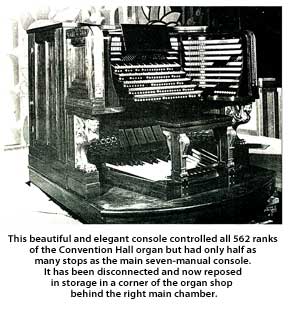
Not only was the blower electric, but so was the remainder of the PABST’S organ’s complex “action”, or control mechanisms. Prior to the PABST installation, pipe organs were a “Rube Goldberg” (but ingenious) arrangement of pneumatic levers, tubes, valves, pistons, and ratchets with pawls, which connected the air through the key console and its “stop” tabs or draw bars by means of “tracker wires” to the pipe chambers or cabinet nearby. There, the valves in the wind chests upon which the pipes sat were opened and closed by these stretched steel piano wires. One can readily imagine the limitations encountered by designers with the console literally tied to its pipes by thousands of stretched wires! With the invention of electric low voltage DC with rudimentary relays, switches, and electromagnetic valves, it was possible for the PABST’S console to be moved about as desired. Even a cable of a thousand electric wires was far more flexible than the tracker wires and pulleys arrangement. Electricity was also faster and eliminated the aggravating delay from key press to pipe sound inherent in old tracker organs. Electric power also made the use of “combination action” (or stops) far easier. This is the technique whereby even a small organ, of, say fifteen ranks (or voices) might be able to have many other sounds simply by connecting more than one rank together at one time by means of a single activated “stop” tablet switch, which then sounded the same note from a single key being depressed, from two or more ranks of pipes. It is little wonder that the famous French organist Alexandre Guilmant was one of many eager to try this state-of-the-art four manual behemoth of over forty “speaking stops” or ranks – not counting the possible permutations of its “combination stops” whether manual or preset. With the excellent acoustics of the PABST, it is as wonderful to hear the organ as an orchestra or chorus.
By means of the PABST, the organ-building firm of FARRAND & VOTEY established their name as the then preeminent electric organ builders for theatres as well as churches, fully twenty years before such names as: MOLLER, KIMBALL, BARTON, and, of course, WURLITZER made the pipe organ famous in the movie palaces with silent film accompaniment.
A projection room was later installed in the PABST in a place over the mezzanine lobby once used as a trunk room, so the organ may have been used to accompany Silent films in later years, but the theatre was never a regular movie house. Those projectors were removed during the 1976 restoration and the space is now the lighting control room. The enclosed exhibits also show that the PABST’S architect was prescient about organs; the PABST’s was only the beginning of a distinguished career until his death in 1935 at age 78.
FARRAND & VOTEY
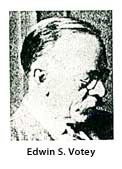
The family of William R. Farrand (1854-1930) purchased the Whitney Organ Company during the 1880s while Edwin Scott Votey (1856-1931) was working for the Estey Organ Company.1 Locating in Detroit, Farrand & Votey’s first products were reed organs. Desiring to branch into the pipe organ business, they purchased the firm of Granville Wood and his son William D. Wood in 18902 and in 1893 they made the major purchase of the Roosevelt company.3 Several of the best Roosevelt men also joined the Farrand & Votey firm and they proceeded to build Roosevelt-style organs. One of these was the fourth organ ever installed in an American theatre, anelectric action 4/43 in the Pabst Theatre, Milwaukee, Wisconsin in 1895. According to William D. Wood, this organ was only the second in American history to be outfitted with an electric blower.4
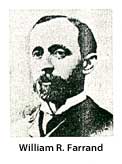
Farrand & Votey were in business until 1897 when the firm divided into two companies: The Farrand Organ Company made reed organs and the Votey Organ Company made pipe organs. In 1899 the Votey Organ Company merged with the Aeolian Company. Farrand & Votey had been making residence organs for Aeolian since 1893 and Edwin Votey had become a member of the Aeolian Company’s board of directors as a result of his inventions and improvements in player piano and player organ technology. In 1901 George Hutchings purchased the Votey Organ Company from Aeolian, forming the Hutchings-Votey Organ Company.5 This firm lasted until 1908 when the Votey name was dropped and the firm name was shortened to the Hutchings Organ Company.6 The Votey name surfaced for the last time in the late 1920s when Aeolian tried to branch out of the residence organ market, the name Aeolian-Votey being used for their church and theatre organs.
A. B. FELGEMAKER ORGAN COMPANY
Abraham B. Felgemaker (1836-1905)1 and Silas L. Derrick established an organ business in Buffalo, New York2 in 1865.3 During 1872 the Derrick & Felgemaker firm moved to Erie, Pennsylvania at the instigation of a group of investors there.4 Sometime after the move the firm name changed to A. B. Felgemaker Organ Company.5 1,289 organs were built6 before the firm went out business voluntarily in 1918,7 at which time the company assets were acquired by the Tellers Organ Company.8 Most of their organs were trackers, although a few electro-pneumatics were built shortly before the end of production.9 The company was highly respected in the industry and was the employer of a number of individuals who went on to become owners of their own firms, such as A. E. Kent (Felgemaker factory superintendent 1894-1918),10 Henry and Ignatius Tellers, W. A. Sommerhof,11 and M. P. Moller.12 This ad was a familiar sight to readers of The Diapason during the ‘teens.

The Midmer-Losh presidency was assumed by Otto Strack in 1931 following Seibert Losh’s departure. Strack was a wealthy architect and engineer who lived in a penthouse apartment atop a New York skyscraper he had designed and built. Seibert Losh sold Strack an organ for this apartment in 1921 and in 1925 Strack designed the new Midmcr-Losh factory building in Merrick. In his earlier days he had been chief engineer for the American Bridge Company17 and earlier still had been the architect for the Pabst Theatre in Milwaukee, Wisconsin. This theatre is interesting in organ history because it contained the fourth organ ever installed in an American theatre, a 4/43 Farrand & Votey.
The Atlantic City organ was completed mechanically in mid-1932. The project had nearly, but not quite, bankrupted the Midmer-Losh company, and Senator Richards tried unsuccessfully to get a further appropriation from the city to complete the tonal finishing.18 Otto Strack died in 1935 at the age of 78, leaving control of the firm to George Losh. In 1938 Losh officially dissolved the corporation and the bank foreclosed the mortgage on their Merrick factory. Fortunately, Losh was able to rent back about one ninth of it to continue the business along with long time employees William Voris and James Light. In 1958 Mr. Losh went into partnership with James Campagnone who had joined the firm in 1953. George Losh retired in 1973 and died in 1975 at the age of 83.19,20 After the death of Mr. Campagnone the Midmer-Losh firm was acquired by W. F. Benzeno, Inc. and remains in the organ business today.21
CONRAD PRESCHLEY
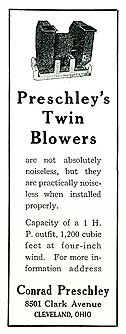
One of Conrad Preschley’s first ads appeared in the July 1916 Diapason. Despite the fact that he continued to advertise through the late 1930s, his sales were insignificant compared to the major blower manufacturers. Theatre organ builder William Wood claimed that the second blower ever installed on an American organ was in the 1895 4/43 Farrand & Votey in the Pabst Theatre, Milwaukee, Wisconsin, installed by a Mr. Preschley.1 If this were actually Conrad Preschley, he is indeed an unsung pioneer in the annals of organ building.
G. MEIDINGER & COMPANY
An organist in his spare time, G. Meidinger began manufacturing electric motors in 1900. He soon got an idea for applying one of his motors to power an organ, the name Meidinger eventually becoming known worldwide as a manufacturer of one of the quietest organ blowers available. According to U. P. Meidinger, grandson of the firm’s founder, 200,000 Meidinger organ blowers have been built, a truly astonishing figure.1
The firm continues today as a family-owned company. U. P. Meidinger and his brother manage the main plant in AIlschwil, Switzerland, a suburb of Basle, and an auxiliary plant in Saint-Louis, France is managed by their brother-in-law. Eighty people are employed in the Swiss plane and twenty more work at the French facility. Current products of the firm are specialty electric motors and a wide variety of air-handling machinery. Organ blower’s account for around 10% of current production.2
On the next six pages is reproduced an extremely rare Meidinger catalog, which sought American business in the early decades of this century. Meidinger sales in the United States were insignificant, however, until the 1950s.
A CLASSIC THEATER… THE PABST
When the Neenah Paper Co. division of the giant Kimberly Clark Corp. was looking for a suitable stage to showcase their new line of Classic® Papers it could not have picked a better one than the PABST. In February of 1979 they approached the PABST to create the following promotional booklet:
A Classic Theatre… The Pabst, “A classic theater on the classic papers from Neenah Paper.” They could have selected far larger and more prestigious theaters such as the Metropolitan Opera, or the refurbished Radio City Music Hall, or the Kennedy Center, or even the venerable Auditorium Theater in Chicago, but they recognized the exceptional beauty and heritage of a smaller structure, the PABST, and they knew that their customers would recognize the classic similarities as well. As you notice the striking list of luminaries printed in gold on their translucent fly leaves, we think that you will agree that there could not have been a finer collaboration of “Classic” equals. The Graphic, Architectural, and Performing Arts are brought together in a mutual celebration as only the century of the PABST could create.
Notice that they reproduced on the inside cover the noted painting by Andrew Aldredge: “Opening Night 1895”, and that the last page displays one of the quaint exit lights which were the only non-electric sources in the theater (they were oil lamps – just in case both the primary and secondary DC electrical generators failed. Nothing was left to chance in the safest theater yet built.) This artistic booklet is more than a pleasant match of equals, it is a tribute to the general recognition of an American landmark.
DOCUMENT DISTRIBUTION AND EPILOGUE
This Application Paper was researched in part, written and compiled and copied and bound by free-lance writer James H. Rankin of P.O. Box 07571, Milwaukee, Wis. 53207, at the request and under the contract of the Executive Director of the PABST THEATER: Mr. Philip Procter with the authorization of the Pabst Theater Board of the City of Milwaukee.
The 4 1/2 pound Paper was sent by Express Mail to:
Jim Charleton
History Division
National Park Service
1100 L Street Room 4209
Washington, D.C. 20013-7127
…on November 24, 1990.
Mr. Philip Procter must be given credit for the text of the 6-page portion: “PABST THEATER: A MULTI-DISCIPLINE, MULTI-CULTURAL HISTORY” as well as for that of the Calendar of Events, enclosed.
Five copies of this Paper were made:
One master copy (containing the original of the Wisconsin Architect issue herein) to the National Park Service
Two copies to the PABST THEATER
One copy to the Public Library
One copy to the author
Part One of the Paper was entitled: “THE PIVOTAL PLACE OF MILWAUKEE’S PABST THEATER TO THE GERMAN-AMERICAN STAGE” ; the 37-page document was bound – like this one – in the Velo Bind system. The master copy sent to the National Park Service also contained a separate Velo® bound “Play List” of approx. 300 pages listing most every German-language performance and actor from 1850 through 1935, from the Bredlow manuscript.
RESULTS OF APPLICATION
Return To Avalon
by Michael Horne
A Madison Operator Has Plans For Movie Palace – What Will The Neighbors Think?
A Madison-based rescuer of vintage theaters is taking a chance that he can stage a revival of the Avalon Theater, 2483 S. Kinnickinnic Ave. Billed as the first movie house in Milwaukee built in the talkie era, the Avalon has been silent since it closed in July 2000. Now comes Henry Doane who plans to purchase the 1929 building and restore it, “primarily for live shows and special events”, he tells Filmmakers.
He’s been down that road before, when he bought the Orpheum Theatre in 1999 when it had been “scheduled to be gutted”, he said. He restored the gem and converted it into a mostly live performance venue, where it draws acts like the Reverend Horton Heat, Richard Thompson and the Yonder Mountain Spring Band. During downtime, he shows movies like the English mystery “Gosford Park” and “The Endurance”, a documentary about a 1914 Antarctic expedition.
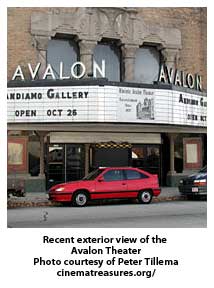
The Orpheum has an extensive restaurant operation offering such nouvelle maison du cinema cuisine as Mussels, Crab Cakes, Tomato Bisque, “Farfalle with creme fraiche, peas, basil, garlic”, and, for the rest of us, ‘The Half Pound Orpheum Burger”, which will run you seven bucks.
At about the time the Avalon shut its doors, Doane leased the Majestic Theatre, which itself had been closed for over a year, and turned it into a cinema. The movie fare ranges from the commercial (Mullholand Drive), to the sure-fire midnight moneymaker, the Rocky Horror Picture Show.
The Avalon will be run more along the lines of the Orpheum, he says. “I don’t plan any restaurant there initially”, Doane says. “I want to do live productions and plays, and receptions and movies on a limited basis.”
But will the magic Doane’s worked in the Capital City translate to success in Milwaukee? Does anybody really want to see Reverend Horton Heat without having a couple drinks at the same time?
Doane says he wants a liquor license for his operation, which will require the cooperation of neighbors and Alderman Suzanne Breier. This support was not forthcoming when the current owners, Greg Cepanica and Craig Ellsworth, lobbied for it a few years ago. Although Bay View labels itself as “Milwaukee’s Other East Side”, in many ways it is The Same South Side, a place where you shovel your sidewalk throughout the snowstorm, and if the lawnmower is broken you go out and cut the grass with a scissors if you have to.
Doane takes pains to insist that neighborhood concerns are uppermost in his mind, and explains, “I would not do any operation here that the neighbors or community would find objectionable”. Don’t look for him to stage “DeathFest”, or “Metal Madness”. And don’t expect him to put just any junk on the screen, either. “I’d like to show movies occasionally. But I show movies whether or not they are commercially viable. If I am going to show them, they might as well be good”.
He admits that for him to successfully open the business, he will have to spend time in Milwaukee, getting to know the community. “I have not yet met Ald. Breier”, he said, “But I look forward to and I will be coming down to Milwaukee weekly”.
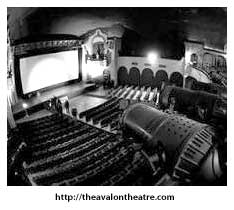
There will be plenty to keep him busy here. To be fair, the building, with its 10,000 sq. ft. of retail space, 19 apartments and 27,000 sq. ft., 1,200 seat theater was in rough shape when the current owners purchased it, and that was a source of some neighborhood disaffection with the operation, which manifested itself as opposition to their being granted a liquor license. The owners remodeled the apartments, leased the storefronts and made some changes to the theater. Any revenue from liquor sales probably would not have been sufficient for them to complete the transformation Doane, with his considerable resources, envisions.
“I want to put the building back to its original configuration”, like he did with the Orpheum, he says. This will take some doing. Theater historian James H. Rankin, in an architectural assessment of the Avalon, notes that the present “picture sheet” (movie screen), which dates to the 1950’s, fronts the once useable full stage; having no curtain in front of the screen, it creates a cold look to the otherwise charming auditorium, designed in the “atmospheric” style by local architect Russell Barr Williamson.
Doane would bring back the charm, he says. “I want to put the screen back behind the curtain, uncover the orchestra pit, and reveal hidden architectural details’. This would restore the utility of the stage for a variety of live performances.
Others have had ambitious plans for Milwaukee landmarks in the past, and when many of the Cream City’s movie palaces fell to the wrecking ball they took with them the hopes of undercapitalized dreamers who wanted to save these great buildings.
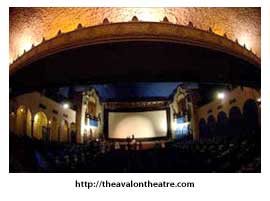
The evidence, however, is that Doane, 38, is of a different breed. Although he was born in San Francisco, he says he has lived in Madison for most of his life. The upscale menu of the Orpheum Lobby Restaurant, which is open for breakfast, brunch, luncheon, dinner and late night dining, reflects his interest in cuisine developed when he was a restaurant cook. “But I realized I wasn’t going to make a living as a chef, so in 1990 I got some friends together and opened the Blue Marlin, and then in 1996 I opened Tourneado’s Steak House”. Both restaurants are in Madison, and have liquor licenses with good records, he says.
His success with the Orpheum, built in 1927 and the Majestic, which dates to 1906, shows that he is familiar with the restoration and maintenance of movie houses from the golden era of Hollywood. His experience in Madison, with its considerable base of university and professional people could translate to Kinnickinnic Ave., where a shifting demographic has found many younger, educated people displacing the elderly blue-collar survivors of an earlier industrial age, in a neighborhood that was once virtually isolated from the rest of the community.
Today, places like Club Garibaldi and the Cactus Club offer regular live music in the neighborhood. Both clubs received approval of their cabaret licenses after the operators demonstrated to the neighbors and the alderman that they could manage their affairs without the attendant scares of loitering, littering and public urination, subjects of persistent and consuming interest to Milwaukeeans in general, and south siders in particular. Just up the block, the Boulevard Ensemble, 2250 S. Kinnickinnic Ave. has been offering live theater in its storefront space for years, and the troupe is in the process of purchasing its rented home.
Doane’s challenge, it seems, will be to sell his innovative plans for his multi-purpose building to a neighborhood that is far more traditional (and residential) than his accustomed Madison base. On the other hand, the south side neighborhood of Bayview, if it is to fully embrace its non-industrial future, must adapt to the entertainment needs of a new generation of residents, and understand that “outsiders” from as far north as Brady Street might from time to time park outside of their houses for a few hours during concerts, and that they promise to leave in a quiet, orderly fashion, without loitering, littering, or that other thing.
The Last Drive-In
by Tim Lambrecht
A few weeks ago, when the Winter finally began to break and we had our first sixty degree day of the Spring, I thought to myself, hmmm, I wonder when the drive-ins will be opening, should be soon.
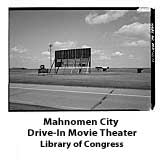
The start of the drive-in season signals the beginning of summer to me, as the start of the baseball season does for other people.
By coincidence, the very next day, I saw a news story, which told of the beginning of the demolition of the 41-Twin drive-in on South 27th Street.
I thought, there goes another drive-in. I had been to the 41-Twin a number of times over the past few years. (Anyone who frequents drive-ins can’t help but notice their options have been dwindling each year.) What upset me was when they said that this was the last operating drive-in in the Milwaukee area! Now, if I want to go to a drive-in, I think have to go up to the Dells!
Now I admit to be overly nostalgic at times, (I prefer County Stadium to Miller Park) but I’m not naive either. I understand the economic realities of operating a drive-in movie theatre. While huge multiplex movie theatres are popping up in all areas, the drive-ins have been dying a slow, painful death, one-by-one.
Growing up on the north side of town, my friends and I used to frequent the Starlight drive-in just off I- 43. We used to see all types of movies, everything from Cheech and Chong double features, (cough cough), to the predictable comedy and action film pairings that were so routinely paired. And lest we forget the dusk-to-dawn horror film marathons.) But we didn’t always go for the movies. We’d simply make plans to go to the drive-in, sometimes not even knowing what movies were playing.
I’m sure everyone, who is at least in their mid-twenties, has a drive-in memory or two themselves. From the steamy dates to the concession stands, to the silly cartoons counting off the minutes until the next feature, there was always something to do.
The drive-in movie experience is much different than a standard theater-going experience. First of course there are the cars. As you drive through the aisles of cars looking for a speaker that worked, you may recognize a friend’s car in a nearby spot. (My friend Paul even found his dream car, a 1970 Plymouth Roadrunner at a drive-in. He talked to the owner, who just happened to be selling it, and before long, Paul was driving it. It is unlikely that scenario would’ve played itself out in a standard theatre parking lot setting.)
Then there is the feeling of community. Despite the fact that couples or groups would each be in their own car, there was a lot of interaction at drive-ins. Many drive-ins had play areas for the kids near the screen, where they could play on a swing set or slide with other kids while their parents or siblings were nearby.
Drive-ins were also good for interaction between friends. More often than not, you’d sit through a bad movie to get to one you wanted to see. Well, during that bad movie, you and your friends had time to talk, go to the concession stand for some snacks, or whatever.
It’s sad that Milwaukee cannot support at least one drive-in theatre. It’s also sad that future generations will not know have a drive-in experience of their own, and will not know what they were except for watching TV shows like Happy Days.
Unfortunately, it appears that the drive-in has slipped from a summertime option to mere nostalgia.
